Novel Uses
WENNOGLE; Lawrence P.
U.S. patent application number 16/219589 was filed with the patent office on 2019-06-27 for novel uses. This patent application is currently assigned to INTRA-CELLULAR THERAPIES, INC.. The applicant listed for this patent is INTRA-CELLULAR THERAPIES, INC.. Invention is credited to Lawrence P. WENNOGLE.
| Application Number | 20190192519 16/219589 |
| Document ID | / |
| Family ID | 51538509 |
| Filed Date | 2019-06-27 |

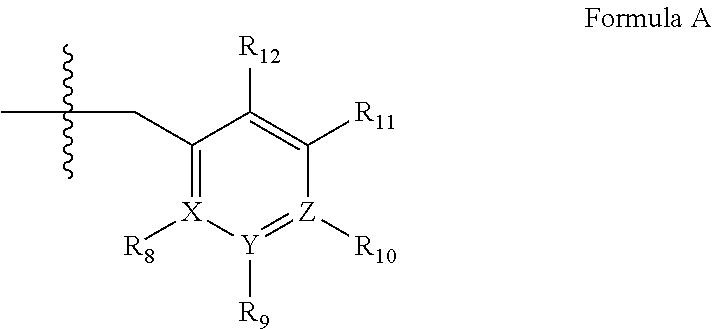
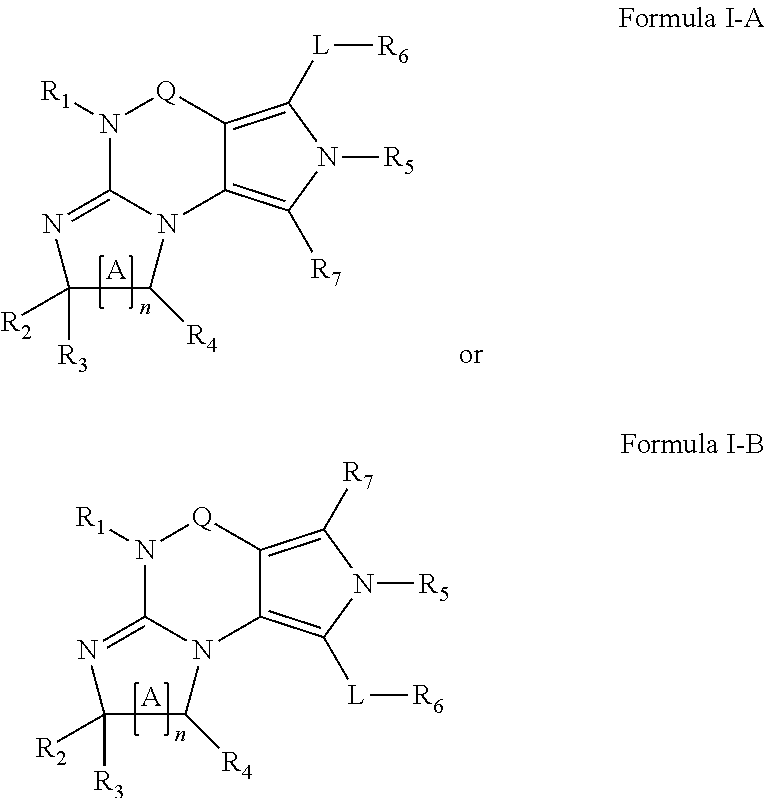


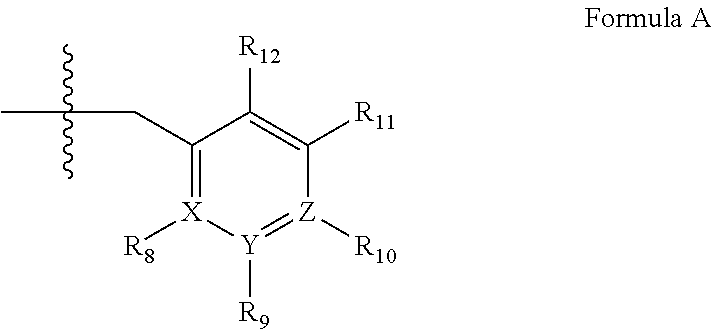




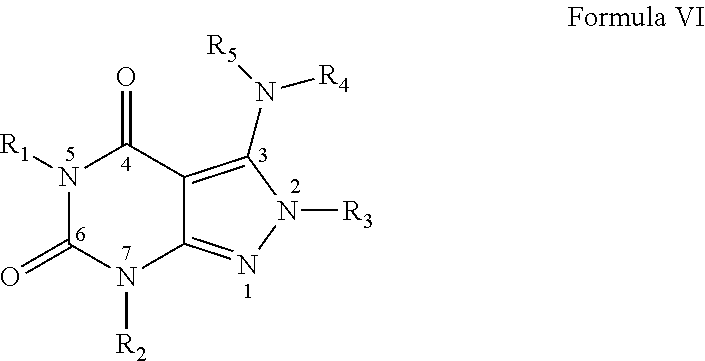

View All Diagrams
| United States Patent Application | 20190192519 |
| Kind Code | A1 |
| WENNOGLE; Lawrence P. | June 27, 2019 |
NOVEL USES
Abstract
The subject matter generally relates to methods of treatment and/or prophylaxis of CNS diseases, disorders, and/or injuries. In one aspect, the subject matter relates to inhibitors of phosphodiesterase 1 (PDE1) as neuroprotective agents and/or neural regenerative agents. In a further aspect, the subject matter relates to individuals that are at risk for the development of CNS disease or disorder.
| Inventors: | WENNOGLE; Lawrence P.; (Hillsborough, NJ) | ||||||||||
| Applicant: |
|
||||||||||
|---|---|---|---|---|---|---|---|---|---|---|---|
| Assignee: | INTRA-CELLULAR THERAPIES,
INC. New York NY |
||||||||||
| Family ID: | 51538509 | ||||||||||
| Appl. No.: | 16/219589 | ||||||||||
| Filed: | December 13, 2018 |
Related U.S. Patent Documents
| Application Number | Filing Date | Patent Number | ||
|---|---|---|---|---|
| 15406346 | Jan 13, 2017 | 10183023 | ||
| 16219589 | ||||
| 14777448 | Sep 15, 2015 | 9545406 | ||
| PCT/US2014/030412 | Mar 17, 2014 | |||
| 15406346 | ||||
| 61799603 | Mar 15, 2013 | |||
| Current U.S. Class: | 1/1 |
| Current CPC Class: | A61K 31/519 20130101; A61K 31/527 20130101; G01N 33/84 20130101; A61P 25/02 20180101; A61P 25/16 20180101; G01N 2800/28 20130101; G01N 2333/4727 20130101; A61K 31/517 20130101; A61P 25/14 20180101; A61P 25/28 20180101; A61K 31/53 20130101 |
| International Class: | A61K 31/519 20060101 A61K031/519; A61K 31/53 20060101 A61K031/53; A61K 31/527 20060101 A61K031/527; A61P 25/02 20060101 A61P025/02; A61P 25/28 20060101 A61P025/28; A61K 31/517 20060101 A61K031/517; A61P 25/16 20060101 A61P025/16; A61P 25/14 20060101 A61P025/14; G01N 33/84 20060101 G01N033/84 |
Claims
1. A method for the prophylaxis and/or treatment of a CNS disease, disorder, and/or injury, wherein the method comprises the administration of an effective amount of a PDE1 inhibitor (e.g., any compound described herein, e.g., any compound of Formula I-XI) to a subject, wherein the administration of the PDE1 inhibitor modulates the subject's level of intracellular cAMP.
2. A method of claim 1, wherein the PDE1 inhibitor is compound of Formula II: ##STR00055## wherein (i) Q is C(.dbd.O), C(.dbd.S), C(.dbd.N(R.sub.20)) or CH.sub.2; (ii) L is a single bond, --N(H)--, --CH.sub.2--, --S--, --S(O)-- or --S(O.sub.2)--; (iii) R.sub.1 is H or C.sub.1-4 alkyl (e.g., methyl); (iv) R.sub.4 is H or C.sub.1-6 alkyl (e.g., methyl or isopropyl) and R.sub.2 and R.sub.3 are, independently, H C.sub.1-6alkyl (e.g., methyl, isopropyl) optionally substituted with halo or hydroxy (e.g., R.sub.2 and R.sub.3 are both methyl, or R.sub.2 is H and R.sub.3 is methyl, ethyl, isopropyl or hydroxyethyl), aryl, heteroaryl, (optionally hetero)arylalkoxy, (optionally hetero)arylC.sub.1-6alkyl; or R.sub.2 and R.sub.3 together form a 3- to 6-membered ring; or R.sub.2 is H and R.sub.3 and R.sub.4 together form a di-, tri- or tetramethylene bridge (pref. wherein the R.sub.3 and R.sub.4 together have the cis configuration, e.g., where the carbons carrying R.sub.3 and R.sub.4 have the R and S configurations, respectively); or (v) R.sub.5 is g) -D-E-F, wherein: D is C.sub.1-4alkylene (e.g., methylene, ethylene or prop-2-yn-1-ylene); E is a single bond, C.sub.2-4alkynylene (e.g., --C.ident.C--), arylene (e.g., phenylene) or heteroarylene (e.g., pyridylene); F is H, aryl (e.g., phenyl), heteroaryl (e.g., pyridyl, diazolyl, triazolyl, for example, pyrid-2-yl, imidazol-1-yl, 1,2,4-triazol-1-yl), halo (e.g., F, Br, Cl), haloC.sub.1-4alkyl (e.g., trifluoromethyl), --C(O)--R.sub.15, --N(R.sub.16)(R.sub.17), or C.sub.3-7cycloalkyl optionally containing at least one atom selected from a group consisting of N or O (e.g., cyclopentyl, cyclohexyl, pyrrolidinyl (e.g., pyrrolidin-3-yl), tetrahydro-2H-pyran-4-yl, or morpholinyl); wherein D, E and F are independently and optionally substituted with one or more halo (e.g., F, Cl or Br), C.sub.1-4alkyl (e.g., methyl), haloC.sub.1-4alkyl (e.g., trifluoromethyl), C.sub.1-4alkoxy (e.g., methoxy), hydroxy, C.sub.1-4carboxy, or an additional aryl or heteroaryl (e.g., biphenyl or pyridylphenyl), for example, F is heteroaryl, e.g., pyridyl substituted with one or more halo (e.g., 6-fluoropyrid-2-yl, 5-fluoropyrid-2-yl, 6-fluoropyrid-2-yl, 3-fluoropyrid-2-yl, 4-fluoropyrid-2-yl, 4,6-dichloropyrid-2-yl), haloC.sub.1-4alkyl (e.g., 5-trifluoromethylpyrid-2-yl) or C.sub.1-4alkyl (e.g., 5-methylpyrid-2-yl), or F is aryl, e.g., phenyl, substituted with one or more halo (e.g., 4-fluorophenyl) or F is a C.sub.3-7heterocycloalkyl (e.g., pyrrolidinyl) optionally substituted with a C.sub.1-6alkyl (e.g., 1-methylpyrrolidin-3-yl); or h) a substituted heteroarylalkyl, e.g., substituted with haloC.sub.1-4alkyl; i) attached to the nitrogen on the pyrrolo portion of Formula II-A or II-B and is a moiety of Formula A ##STR00056## wherein X, Y and Z are, independently, N or C, and R.sub.8, R.sub.9, R.sub.11 and R.sub.12 are independently H or halogen (e.g., Cl or F), and R.sub.10 is halogen, C.sub.1-4alkyl, haloC.sub.1-4alkyl (e.g., trifluoromethyl) C.sub.1-4alkoxy (e.g. methoxy), C.sub.3-7cycloalkyl, heteroC.sub.3-7cycloalkyl (e.g., pyrrolidinyl or piperidinyl), C.sub.1-4haloalkyl (e.g., trifluoromethyl), aryl (e.g., phenyl), heteroaryl (e.g., pyridyl (for example pyrid-2-yl or pyrid-4-yl), or thiadiazolyl (e.g., 1,2,3-thiadiazol-4-yl)), diazolyl (e.g., imidazol-1-yl), triazolyl (e.g., 1,2,4-triazol-1-yl), tetrazolyl, arylcarbonyl (e.g., benzoyl), alkylsulfonyl (e.g., methylsulfonyl), heteroarylcarbonyl, or alkoxycarbonyl; wherein the aryl, heteroaryl, cycloalkyl or heterocycloalkyl is independently, optionally substituted with one or more C.sub.1-4alkyl (e.g., methyl), halogen (e.g., chloro or fluoro), haloC.sub.1-4alkyl (e.g., trifluoromethyl), hydroxy, C.sub.1-4carboxy, --SH or an additional aryl, heteroaryl (e.g., biphenyl or pyridylphenyl) or C.sub.3-8cycloalkyl, preferably R.sub.10 is phenyl, pyridyl, piperidinyl or pyrrolidinyl optionally substituted with the substituents previously defined, e.g. optionally substituted with halo or alkyl provided that when X, Y, or Z is nitrogen, R.sub.8, R.sub.9, or R.sub.10, respectively, is not present; (vi) R.sub.6 is H, C.sub.1-4alkyl (e.g., methyl, ethyl, n-propyl, isobutyl), C.sub.3-7cycloalkyl (e.g., cyclopentyl or cyclohexyl), heteroC.sub.3-7cycloalkyl (e.g., pyrrolidinyl, piperidinyl, morpholinyl), aryl (e.g., phenyl), heteroaryl (e.g., pyrid-4-yl), arylC.sub.1-4alkyl (e.g., benzyl), arylamino (e.g., phenylamino), heteroarylamino, N,N-diC.sub.1-4alkylamino, N,N-diarylamino, N-aryl-N-(arylC.sub.1-4alkyl)amino (e.g., N-phenyl-N-(1,1'-biphen-4-ylmethyl)amino), or --N(R.sub.18)(R.sub.19), wherein the aryl and heteroaryl are optionally substituted with one or more C.sub.1-4alkyl (e.g., methyl), halogen (e.g., chloro or fluoro), haloC.sub.1-4alkyl (e.g., trifluoromethyl), hydroxy, C.sub.1-4carboxy, or an additional aryl, heteroaryl (e.g., biphenyl or pyridylphenyl) or C.sub.3-8cycloalkyl; (vii) R.sub.7 is H, C.sub.1-6alkyl (e.g., methyl or ethyl), halogen (e.g., Cl), --N(R.sub.18)(R.sub.19), hydroxy or C.sub.1-6alkoxy; (viii) n=0 or 1; (ix) when n=1, A is --C(R.sub.13R.sub.14)--, wherein R.sub.13 and R.sub.14, are, independently, H or C.sub.1-4alkyl, aryl, heteroaryl, (optionally hetero)arylC.sub.1-4alkoxy, (optionally hetero)arylC.sub.1-4alkyl or R.sub.14 can form a bridge with R.sub.2 or R.sub.4; (x) R.sub.15 is C.sub.1-4alkyl, haloC.sub.1-4alkyl, --OH or --OC.sub.1-4alkyl (e.g., --OCH.sub.3) (xi) R.sub.16 and R.sub.17 are independently H or C.sub.1-4alkyl; (xii) R.sub.18 and R.sub.19 are independently H, C.sub.1-4alky (e.g., methyl, ethyl, n-propyl, isobutyl), C.sub.3-8cycloalky (e.g., cyclohexyl or cyclopenyl), heteroC.sub.3-8cycloalky (e.g., pyrrolidinyl, piperidinyl, morpholinyl), aryl (e.g., phenyl) or heteroaryl (e.g., pyridyl), wherein said aryl and heteroaryl are optionally substituted with one or more halo (e.g., fluorophenyl, e.g., 4-fluorophenyl), hydroxy (e.g., hydroxyphenyl, e.g., 4-hydroxyphenyl or 2-hydroxyphenyl), C.sub.1-4alkyl (e.g., methyl), haloC.sub.1-4alkyl (e.g., trifluoromethyl), C.sub.1-4carboxy, or an additional aryl, heteroaryl (e.g., biphenyl or pyridylphenyl) or C.sub.3-8cycloalkyl, (xiii) R.sub.20 is H, C.sub.1-4alkyl or C.sub.3-7cycloalkyl; in free or salt form.
3. A method of claim 1, wherein the PDE1 inhibitor is compound of Formula I: ##STR00057## wherein (i) Q is C(.dbd.O), C(.dbd.S), C(.dbd.N(R.sub.20)) or CH.sub.2; (ii) L is a single bond, --N(H)--, --CH.sub.2--, --S--, --S(O)-- or --S(O.sub.2)--; (iii) R.sub.1 is H or C.sub.1-4 alkyl (e.g., methyl); (iv) R.sub.4 is H or C.sub.1-6 alkyl (e.g., methyl or isopropyl) and R.sub.2 and R.sub.3 are, independently, H or C.sub.1-6alkyl (e.g., methyl, isopropyl) optionally substituted with halo or hydroxy (e.g., R.sub.2 and R.sub.3 are both methyl, or R.sub.2 is H and R.sub.3 is methyl, ethyl, isopropyl or hydroxyethyl), aryl, heteroaryl, (optionally hetero)arylalkoxy, or (optionally hetero)arylC.sub.1-6alkyl; or R.sub.2 is H and R.sub.3 and R.sub.4 together form a di-, tri- or tetramethylene bridge (pref. wherein the R.sub.3 and R.sub.4 together have the cis configuration, e.g., where the carbons carrying R.sub.3 and R.sub.4 have the R and S configurations, respectively); (v) R.sub.5 is d) -D-E-F, wherein: D is C.sub.1-4alkylene (e.g., methylene, ethylene or prop-2-yn-1-ylene); E is a single bond, C.sub.2-4alkynylene (e.g., --C.ident.C--), arylene (e.g., phenylene) or heteroarylene (e.g., pyridylene); F is H, aryl (e.g., phenyl), heteroaryl (e.g., pyridyl, diazolyl, triazolyl, for example, pyrid-2-yl, imidazol-1-yl, 1,2,4-triazol-1-yl), halo (e.g., F, Br, Cl), haloC.sub.1-4alkyl (e.g., trifluoromethyl), --C(O)--R.sub.15, --N(R.sub.16)(R.sub.17), or C.sub.3-7cycloalkyl optionally containing at least one atom selected from a group consisting of N or O (e.g., cyclopentyl, cyclohexyl, pyrrolidinyl (e.g., pyrrolidin-3-yl), tetrahydro-2H-pyran-4-yl, or morpholinyl); wherein D, E and F are independently and optionally substituted with one or more halo (e.g., F, Cl or Br), C.sub.1-4alkyl (e.g., methyl), haloC.sub.1-4alkyl (e.g., trifluoromethyl), for example, F is heteroaryl, e.g., pyridyl substituted with one or more halo (e.g., 6-fluoropyrid-2-yl, 5-fluoropyrid-2-yl, 6-fluoropyrid-2-yl, 3-fluoropyrid-2-yl, 4-fluoropyrid-2-yl, 4,6-dichloropyrid-2-yl), haloC.sub.1-4alkyl (e.g., 5-trifluoromethylpyrid-2-yl) or C.sub.1-4alkyl (e.g., 5-methylpyrid-2-yl), or F is aryl, e.g., phenyl, substituted with one or more halo (e.g., 4-fluorophenyl) or F is a C.sub.3-7heterocycloalkyl (e.g., pyrrolidinyl) optionally substituted with a C.sub.1-6alkyl (e.g., 1-methylpyrrolidin-3-yl); or e) a substituted heteroarylalkyl, e.g., substituted with haloalkyl; f) attached to the nitrogen on the pyrrolo portion of Formula I-A or I--B and is a moiety of Formula A ##STR00058## wherein X, Y and Z are, independently, N or C, and R.sub.8, R.sub.9, R.sub.11 and R.sub.12 are independently H or halogen (e.g., Cl or F), and R.sub.10 is halogen, C.sub.1-4alkyl, C.sub.3-7cycloalkyl, C.sub.1-4haloalkyl (e.g., trifluoromethyl), aryl (e.g., phenyl), heteroaryl (e.g., pyridyl (for example pyrid-2-yl), or thiadiazolyl (e.g., 1,2,3-thiadiazol-4-yl)), diazolyl, triazolyl, tetrazolyl, arylcarbonyl (e.g., benzoyl), alkylsulfonyl (e.g., methylsulfonyl), heteroarylcarbonyl, or alkoxycarbonyl; provided that when X, Y, or Z is nitrogen, R.sub.8, R.sub.9, or R.sub.10, respectively, is not present; (vi) R.sub.6 is H, C.sub.1-4alkyl, C.sub.3-7cycloalkyl (e.g., cyclopentyl), aryl (e.g., phenyl), heteroaryl (e.g., pyrid-4-yl), arylC.sub.1-4alkyl (e.g., benzyl), arylamino (e.g., phenylamino), heteroarylamino, N,N-diC.sub.1-4alkylamino, N,N-diarylamino, N-aryl-N-(arylC.sub.1-4alkyl)amino (e.g., N-phenyl-N-(1,1'-biphen-4-ylmethyl)amino), or --N(R.sub.18)(R.sub.19); wherein the aryl or heteroaryl is optionally substituted with one or more halo (e.g., F, Cl), hydroxy or C.sub.1-6alkoxy; (vii) R.sub.7 is H, C.sub.1-6alkyl, halogen (e.g., Cl), --N(R.sub.18)(R.sub.19); (viii) n=0 or 1; (ix) when n=1, A is --C(R.sub.13R.sub.14)--, wherein R.sub.13 and R.sub.14, are, independently, H or C.sub.1-4alkyl, aryl, heteroaryl, (optionally hetero)arylC.sub.1-4alkoxy or (optionally hetero)arylC.sub.1-4alkyl; (x) R.sub.15 is C.sub.1-4alkyl, haloC.sub.1-4alkyl, --OH or --OC.sub.1-4alkyl (e.g., --OCH.sub.3) (xi) R.sub.16 and R.sub.17 are independently H or C.sub.1-4alkyl; (xii) R.sub.18 and R.sub.19 are independently H, C.sub.1-4alky or aryl (e.g., phenyl) wherein said aryl is optionally substituted with one or more halo (e.g., fluorophenyl, e.g., 4-fluorophenyl) or hydroxy (e.g., hydroxyphenyl, e.g., 4-hydroxyphenyl or 2-hydroxyphenyl) (xiii) R.sub.20 is H, C.sub.1-4alkyl or C.sub.3-7cycloalkyl; in free or salt form.
4. A method of claim 1, wherein the PDE1 inhibitor is compound of Formula III: ##STR00059## wherein (i) Q is C(.dbd.S), C(.dbd.N(R.sub.20)) or CH.sub.2; (ii) L is a single bond, --N(H)--, --CH.sub.2--; (iii) R.sub.1 is H or C.sub.1-4 alkyl (e.g., methyl or ethyl); (iv) R.sub.4 is H or C.sub.1-6 alkyl (e.g., methyl, isopropyl) and R.sub.2 and R.sub.3 are, independently: H or C.sub.1-6alkyl (e.g., methyl or isopropyl) optionally substituted with halo or hydroxy (e.g., R.sub.2 and R.sub.3 are both methyl, or R.sub.2 is H and R.sub.3 is methyl, ethyl, isopropyl or hydroxyethyl), aryl, heteroaryl, (optionally hetero)arylalkoxy, (optionally hetero)arylC.sub.1-6alkyl, or R.sub.2 and R.sub.3 together form a 3- to 6-membered ring; or R.sub.2 is H and R.sub.3 and R.sub.4 together form a di-, tri- or tetramethylene bridge (pref. wherein the R.sub.3 and R.sub.4 together have the cis configuration, e.g., where the carbons carrying R.sub.3 and R.sub.4 have the R and S configurations, respectively); (v) R.sub.5 is j) -D-E-F, wherein: D is C.sub.1-4alkylene (e.g., methylene, ethylene or prop-2-yn-1-ylene); E is a single bond, C.sub.2-4alkynylene (e.g., --C.ident.C--), arylene (e.g., phenylene) or heteroarylene (e.g., pyridylene); F is H, aryl (e.g., phenyl), heteroaryl (e.g., pyridyl, diazolyl, triazolyl, for example, pyrid-2-yl, imidazol-1-yl, 1,2,4-triazol-1-yl), halo (e.g., F, Br, Cl), haloC.sub.1-4alkyl (e.g., trifluoromethyl), --C(O)--R.sub.15, --N(R.sub.16)(R.sub.17), --S(O).sub.2R.sub.21 or C.sub.3-7cycloalkyl optionally containing at least one atom selected from a group consisting of N or O (e.g., cyclopentyl, cyclohexyl, pyrrolidinyl (e.g., pyrrolidin-3-yl), tetrahydro-2H-pyran-4-yl, or morpholinyl); wherein D, E and F are independently and optionally substituted with one or more: halo (e.g., F, Cl or Br), C.sub.1-4alkyl (e.g., methyl), haloC.sub.1-4alkyl (e.g., trifluoromethyl), C.sub.1-4alkoxy) or C.sub.1-4alkyl (e.g., 5-methylpyrid-2-yl), for example, F is heteroaryl, e.g., pyridyl substituted with one or more halo (e.g., 6-fluoropyrid-2-yl, 5-fluoropyrid-2-yl, 6-fluoropyrid-2-yl, 3-fluoropyrid-2-yl, 4-fluoropyrid-2-yl, 4,6-dichloropyrid-2-yl), or F is aryl, e.g., phenyl, substituted with one or more halo (e.g., 4-fluorophenyl) or F is a C.sub.3-7heterocycloalkyl (e.g., pyrrolidinyl) optionally substituted with a C.sub.1-6alkyl (e.g., 1-methylpyrrolidin-3-yl); or k) a substituted heteroarylalkyl, e.g., substituted with haloalkyl; l) attached to one of the nitrogens on the pyrazolo portion of Formula III and is a moiety of Formula A ##STR00060## wherein X, Y and Z are, independently, N or C, and R.sub.8, R.sub.9, R.sub.11 and R.sub.12 are independently H or halogen (e.g., Cl or F), and R.sub.10 is: halogen, C.sub.1-4alkyl, C.sub.3-7cycloalkyl, hetC.sub.3-7cycloalkyl (e.g., pyrrolidinyl or piperidinyl), C.sub.1-4haloalkyl (e.g., trifluoromethyl), aryl (e.g., phenyl), heteroaryl (e.g., pyridyl (for example pyrid-2-yl), or thiadiazolyl (e.g., 1,2,3-thiadiazol-4-yl)), diazolyl, triazolyl, tetrazolyl, arylcarbonyl (e.g., benzoyl), alkylsulfonyl (e.g., methylsulfonyl), heteroarylcarbonyl, or alkoxycarbonyl; wherein the aryl, heteroaryl, cycloalkyl or heterocycloalkyl is independently and optionally substituted with one or more halo (e.g., F or Cl), C.sub.1-4alkyl, C.sub.1-4alkoxy, C.sub.1-4haloalkyl (e.g., trifluoromethyl), --SH; preferably R.sub.10 is phenyl, pyridyl, piperidinyl or pyrrolidinyl optionally substituted with the substituents previously defined, e.g. optionally substituted with halo or alkyl provided that when X, Y, or Z is nitrogen, R.sub.8, R.sub.9, or R.sub.10, respectively, is not present; (vi) R.sub.6 is H, C.sub.1-4alkyl, C.sub.3-7cycloalkyl (e.g., cyclopentyl), aryl (e.g., phenyl), heteroaryl (e.g., pyridyl, for example, pyrid-4-yl), arylC.sub.1-4alkyl (e.g., benzyl), arylamino (e.g., phenylamino), heteroarylamino, N,N-diC.sub.1-4alkylamino, N,N-diarylamino, N-aryl-N-(arylC.sub.1-4alkyl)amino (e.g., N-phenyl-N-(1,1'-biphen-4-ylmethyl)amino), or --N(R.sub.18)(R.sub.19); wherein the aryl or heteroaryl is optionally substituted with one or more halo (e.g., F, Cl), hydroxy, C.sub.1-6alkyl, C.sub.1-6alkoxy, C.sub.3-8cycloalkyl, for example, R.sub.6 is 4-hydroxyphenyl or 4-fluorophenyl, (vii) n=0 or 1; (viii) when n=1, A is --C(R.sub.13R.sub.14)--, wherein R.sub.13 and R.sub.14, are, independently, H or C.sub.1-4alkyl, aryl, heteroaryl, (optionally hetero)arylC.sub.1-4alkoxy, (optionally hetero)arylC.sub.1-4alkyl or R.sub.13 or R.sub.14 can form a bridge with R.sub.2 or R.sub.4; (ix) R.sub.15 is C.sub.1-4alkyl, haloC.sub.1-4alkyl, --OH or --OC.sub.1-4alkyl (e.g., --OCH.sub.3) (x) R.sub.16 and R.sub.17 are independently H or C.sub.1-4alkyl; (xi) R.sub.18 and R.sub.19 are independently H, C.sub.1-4alky, C.sub.3-8cycloalkyl, heteroC.sub.3-8cycloalkyl, aryl (e.g., phenyl), or heteroaryl, wherein said aryl or heteroaryl is optionally substituted with one or more halo (e.g., fluorophenyl, e.g., 4-fluorophenyl), hydroxy (e.g., hydroxyphenyl, e.g., 4-hydroxyphenyl or 2-hydroxyphenyl), C.sub.1-6alkyl, haloC.sub.1-6alkyl, C.sub.1-6alkoxy, aryl, heteroaryl, or C.sub.3-8cycloalkyl; (xii) R.sub.20 is H, C.sub.1-4alkyl (e.g., methyl) or C.sub.3-7cycloalkyl, (xiii) R.sub.21 is C.sub.1-6alkyl; in free or salt form.
5. A method of claim 1, wherein the PDE1 inhibitor is compound of Formula IV: ##STR00061## wherein (i) Q is C(.dbd.S), C(.dbd.N(R.sub.20)) or CH.sub.2; (ii) L is a single bond, --N(H)--, --CH.sub.2--; (iii) R.sub.1 is H or C.sub.1-4 alkyl (e.g., methyl or ethyl); (iv) R.sub.4 is H or C.sub.1-6 alkyl (e.g., methyl, isopropyl) and R.sub.2 and R.sub.3 are, independently, H or C.sub.1-6alkyl (e.g., methyl or isopropyl) optionally substituted with halo or hydroxy (e.g., R.sub.2 and R.sub.3 are both methyl, or R.sub.2 is H and R.sub.3 is methyl, ethyl, isopropyl or hydroxyethyl), aryl, heteroaryl, (optionally hetero)arylalkoxy, or (optionally hetero)arylC.sub.1-6alkyl; or R.sub.2 is H and R.sub.3 and R.sub.4 together form a di-, tri- or tetramethylene bridge (pref. wherein the R.sub.3 and R.sub.4 together have the cis configuration, e.g., where the carbons carrying R.sub.3 and R.sub.4 have the R and S configurations, respectively); (v) R.sub.5 is d) -D-E-F, wherein: D is C.sub.1-4alkylene (e.g., methylene, ethylene or prop-2-yn-1-ylene); E is a single bond, C.sub.2-4alkynylene (e.g., --C.ident.C--), arylene (e.g., phenylene) or heteroarylene (e.g., pyridylene); F is H, aryl (e.g., phenyl), heteroaryl (e.g., pyridyl, diazolyl, triazolyl, for example, pyrid-2-yl, imidazol-1-yl, 1,2,4-triazol-1-yl), halo (e.g., F, Br, Cl), haloC.sub.1-4alkyl (e.g., trifluoromethyl), --C(O)--R.sub.15, --N(R.sub.16)(R.sub.17), --S(O).sub.2R.sub.21 or C.sub.3-7cycloalkyl optionally containing at least one atom selected from a group consisting of N or O (e.g., cyclopentyl, cyclohexyl, pyrrolidinyl (e.g., pyrrolidin-3-yl), tetrahydro-2H-pyran-4-yl, or morpholinyl); wherein D, E and F are independently and optionally substituted with one or more: halo (e.g., F, Cl or Br), C.sub.1-4alkyl (e.g., methyl), haloC.sub.1-4alkyl (e.g., trifluoromethyl), for example, F is heteroaryl, e.g., pyridyl substituted with one or more halo (e.g., 6-fluoropyrid-2-yl, 5-fluoropyrid-2-yl, 6-fluoropyrid-2-yl, 3-fluoropyrid-2-yl, 4-fluoropyrid-2-yl, 4,6-dichloropyrid-2-yl), haloC.sub.1-4alkyl (e.g., 5-trifluoromethylpyrid-2-yl) or C.sub.1-4alkyl (e.g., 5-methylpyrid-2-yl), or F is aryl, e.g., phenyl, substituted with one or more halo (e.g., 4-fluorophenyl) or F is a C.sub.3-7heterocycloalkyl (e.g., pyrrolidinyl) optionally substituted with a C.sub.1-6alkyl (e.g., 1-methylpyrrolidin-3-yl); or e) a substituted heteroarylalkyl, e.g., substituted with haloalkyl; f) attached to one of the nitrogens on the pyrazolo portion of Formula IV and is a moiety of Formula A ##STR00062## wherein X, Y and Z are, independently, N or C, and R.sub.8, R.sub.9, R.sub.11 and R.sub.12 are independently H or halogen (e.g., Cl or F), and R.sub.10 is: halogen, C.sub.1-4alkyl, C.sub.3-7cycloalkyl, C.sub.1-4haloalkyl (e.g., trifluoromethyl), aryl (e.g., phenyl), heteroaryl (e.g., pyridyl (for example pyrid-2-yl), or thiadiazolyl (e.g., 1,2,3-thiadiazol-4-yl)), diazolyl, triazolyl, tetrazolyl, arylcarbonyl (e.g., benzoyl), alkylsulfonyl (e.g., methylsulfonyl), heteroarylcarbonyl, or alkoxycarbonyl; provided that when X, Y, or Z is nitrogen, R.sub.8, R.sub.9, or R.sub.10, respectively, is not present; (vi) R.sub.6 is H, C.sub.1-4alkyl, C.sub.3-7cycloalkyl (e.g., cyclopentyl), aryl (e.g., phenyl), heteroaryl (e.g., pyridyl, for example, pyrid-4-yl), arylC.sub.1-4alkyl (e.g., benzyl), arylamino (e.g., phenylamino), heteroarylamino, N,N-diC.sub.1-4alkylamino, N,N-diarylamino, N-aryl-N-(arylC.sub.1-4alkyl)amino (e.g., N-phenyl-N-(1,1'-biphen-4-ylmethyl)amino), or --N(R.sub.18)(R.sub.19); wherein the aryl or heteroaryl is optionally substituted with one or more halo (e.g., F, Cl), hydroxy or C.sub.1-6alkoxy, for example, R.sub.6 is 4-hydroxyphenyl or 4-fluorophenyl, (vii) n=0 or 1; (viii) when n=1, A is --C(R.sub.13R.sub.14)--, wherein R.sub.13 and R.sub.14, are, independently, H or C.sub.1-4alkyl, aryl, heteroaryl, (optionally hetero)arylC.sub.1-4alkoxy or (optionally hetero)arylC.sub.1-4alkyl; (ix) R.sub.15 is C.sub.1-4alkyl, haloC.sub.1-4alkyl, --OH or --OC.sub.1-4alkyl (e.g., --OCH.sub.3) (x) R.sub.16 and R.sub.17 are independently H or C.sub.1-4alkyl; (xi) R.sub.18 and R.sub.19 are independently H, C.sub.1-4alky or aryl (e.g., phenyl) wherein said aryl is optionally substituted with one or more halo (e.g., fluorophenyl, e.g., 4-fluorophenyl) or hydroxy (e.g., hydroxyphenyl, e.g., 4-hydroxyphenyl or 2-hydroxyphenyl) (xii) R.sub.20 is H, C.sub.1-4alkyl (e.g., methyl) or C.sub.3-7cycloalkyl, (xiii) R.sub.21 is C.sub.1-6alkyl; in free or salt form.
6. A method of claim 1, wherein the PDE1 inhibitor is compound of Formula V: ##STR00063## wherein (i) R.sub.1 is H or C.sub.1-4 alkyl (e.g., methyl); (ii) R.sub.4 is H or C.sub.1-4 alkyl and R.sub.2 and R.sub.3 are, independently, H or C.sub.1-4 alkyl (e.g., R.sub.2 and R.sub.3 are both methyl, or R.sub.2 is H and R.sub.3 is isopropyl), aryl, heteroaryl, (optionally hetero)arylalkoxy, or (optionally hetero)arylalkyl; or R.sub.2 is H and R.sub.3 and R.sub.4 together form a di-, tri- or tetramethylene bridge (pref. wherein the R.sub.3 and R.sub.4 together have the cis configuration, e.g., where the carbons carrying R.sub.3 and R.sub.4 have the R and S configurations, respectively); (iii) R.sub.5 is a substituted heteroarylalkyl, e.g., substituted with haloalkyl or R.sub.5 is attached to one of the nitrogens on the pyrazolo portion of Formula V and is a moiety of Formula A ##STR00064## wherein X, Y and Z are, independently, N or C, and R.sub.8, R.sub.9, R.sub.11 and R.sub.12 are independently H or halogen (e.g., Cl or F), and R.sub.10 is halogen, alkyl, cycloalkyl, haloalkyl (e.g., trifluoromethyl), aryl (e.g., phenyl), heteroaryl (e.g., pyridyl (for example pyrid-2-yl), or thiadiazolyl (e.g., 1,2,3-thiadiazol-4-yl)), diazolyl, triazolyl, tetrazolyl, arylcarbonyl (e.g., benzoyl), alkylsulfonyl (e.g., methylsulfonyl), heteroarylcarbonyl, or alkoxycarbonyl; provided that when X, Y, or Z is nitrogen, R.sub.8, R.sub.9, or R.sub.10, respectively, is not present; and (iv) R.sub.6 is H, alkyl, aryl, heteroaryl, arylalkyl (e.g., benzyl), arylamino (e.g., phenylamino), heteroarylamino, N,N-dialkylamino, N,N-diarylamino, or N-aryl-N-(arylakyl)amino (e.g., N-phenyl-N-(1,1'-biphen-4-ylmethyl)amino); and (v) n=0 or 1; (vi) when n=1, A is --C(R.sub.13R.sub.14)-- wherein R.sub.13 and R.sub.14, are, independently, H or C.sub.1-4 alkyl, aryl, heteroaryl, (optionally hetero)arylalkoxy or (optionally hetero)arylalkyl; wherein aryl is optionally substituted with C.sub.1-4 alkyl, halogen, haloC.sub.1-4alkyl, hydroxyl or C.sub.1-4carboxy or an additional aryl or heteroaryl; or heteroaryl or thiadiazolyl is optionally substituted with C.sub.1-4alkyl, halogen, haloC.sub.1-4alkyl, hydroxyl or C.sub.1-4carboxy; in free or pharmaceutically acceptable salt form.
7. A method of claim 1, wherein the PDE1 inhibitor is compound of Formula VI: ##STR00065## wherein: (i) R.sub.1 is H or alkyl; (ii) R.sub.2 is H, alkyl, cycloalkyl, haloalkyl, alkylaminoalkyl, hydroxyalkyl, arylalkyl, heteroarylalkyl, or alkoxyarylalkyl; (iii) R.sub.3 is heteroarylmethyl or formula A ##STR00066## wherein X, Y and Z are, independently, N or C, and R.sub.8, R.sub.9, R.sub.11 and R.sub.12 are independently H or halogen; and R.sub.10 is halogen, alkyl, cycloalkyl, haloalkyl, aryl, heteroaryl, alkyl sulfonyl, arylcarbonyl, heteroarylcarbonyl, alkoxycarbonyl, or aminocarbonyl; (iv) R.sub.4 is aryl or heteroaryl; and (v) R.sub.5 is H, alkyl, cycloalkyl, heteroaryl, aryl, p-benzylaryl; provided that when X, Y or X is nitrogen, R.sub.8, R.sub.9 or R.sub.10, respectively, is not present; wherein "alk" or "alkyl" refers to C.sub.1-6 alkyl and "cycloalkyl" refers to C.sub.3-6 cycloalkyl, in free, salt or physiologically hydrolysable and acceptable ester prodrug form.
8. A method of claim 1, wherein the PDE1 inhibitor is compound of Formula VII: ##STR00067## (i) X is C.sub.1-6alkylene (e.g., methylene, ethylene or prop-2-yn-1-ylene); (ii) Y is a single bond, alkynylene (e.g., --C.ident.C--), arylene (e.g., phenylene) or heteroarylene (e.g., pyridylene); (iii) Z is H, aryl (e.g., phenyl), heteroaryl (e.g., pyridyl, e.g., pyrid-2-yl), halo (e.g., F, Br, Cl), haloC.sub.1-6alkyl (e.g., trifluoromethyl), --C(O)--R.sup.1, --N(R.sup.2)(R.sup.3), or C.sub.3-7cycloalkyl optionally containing at least one atom selected from a group consisting of N or O (e.g., cyclopentyl, cyclohexyl, tetrahydro-2H-pyran-4-yl, or morpholinyl); (iv) R.sup.1 is C.sub.1-6alkyl, haloC.sub.1-6alkyl, --OH or --OC.sub.1-6alkyl (e.g., --OCH.sub.3); (v) R.sup.2 and R.sup.3 are independently H or C.sub.1-6alkyl; (vi) R.sup.4 and R.sup.5 are independently H, C.sub.1-6alky or aryl (e.g., phenyl) optionally substituted with one or more halo (e.g., fluorophenyl, e.g., 4-fluorophenyl), hydroxy (e.g., hydroxyphenyl, e.g., 4-hydroxyphenyl or 2-hydroxyphenyl) or C.sub.1-6alkoxy; (vii) wherein X, Y and Z are independently and optionally substituted with one or more halo (e.g., F, Cl or Br), C.sub.1-6alkyl (e.g., methyl), haloC.sub.1-6alkyl (e.g., trifluoromethyl), for example, Z is heteroaryl, e.g., pyridyl substituted with one or more halo (e.g., 6-fluoropyrid-2-yl, 5-fluoropyrid-2-yl, 6-fluoropyrid-2-yl, 3-fluoropyrid-2-yl, 4-fluoropyrid-2-yl, 4,6-dichloropyrid-2-yl), haloC.sub.1-6alkyl (e.g., 5-trifluoromethylpyrid-2-yl) or C.sub.1-6-alkyl (e.g., 5-methylpyrid-2-yl), or Z is aryl, e.g., phenyl, substituted with one or more halo (e.g., 4-fluorophenyl), in free, salt or prodrug form.
9. A method of claim 1, wherein the PDE1 inhibitor is compound of Formula VIII: ##STR00068## wherein (i) R.sub.1 is H or C.sub.1-6alkyl; (ii) R.sub.2 is H, C.sub.1-6alkyl, C.sub.3-8cycloalkyl optionally substituted with one or more amino, C.sub.3-8heterocycloalkyl optionally substituted with C.sub.1-6alkyl, C.sub.3-8cycloalkyl-C.sub.1-6-alkyl, C.sub.1-6haloalkyl, C.sub.0-6alkylaminoC.sub.0-6alkyl, hydroxyC.sub.1-6alkyl, arylC.sub.0-6alkyl, heteroarylalkyl, C.sub.1-6-alkoxyarylC.sub.1-6alkyl, or G-J wherein: G is a single bond or, alkylene; J is cycloalkyl or heterocycloalkyl optionally substituted with alkyl; (iii) R.sub.3 is a) -D-E-F wherein 1. D is single bond, C.sub.1-6alkylene or arylC.sub.1-6alkylene; 2. E is a C.sub.1-6alkylene, arylene, C.sub.1-6alkylarylene, aminoC.sub.1-6alkylene- or amino; and 3. F is heteroC.sub.3-8cycloalkyl optionally substituted with C.sub.1-6alkyl; (iv) R.sub.4 is aryl optionally substituted with one or more halo, hydroxy or C.sub.1-6alkoxy; heteroaryl or heteroC.sub.3-6cycloalkyl; and (v) R.sub.5 is H, C.sub.1-6alkyl, C.sub.3-8cycloalkyl, heteroaryl, aryl or p-benzylaryl; wherein "alk", "alkyl", "haloalkyl" or "alkoxy" refers to C.sub.1-6 alkyl and "cycloalkyl" refers to C.sub.3-8cycloalkyl; in free or salt form.
10. A method of claim 1, wherein the PDE1 inhibitor is compound of Formula IX: ##STR00069## wherein (i) Q is --C(.dbd.S)--, --C(.dbd.N(R.sub.6))-- or --C(R.sub.14)(R.sub.15)--; (ii) R.sub.1 is H or C.sub.1-6alkyl (e.g., methyl or ethyl); (iii) R.sub.2 is H, C.sub.1-6alkyl (e.g., isopropyl, isobutyl, 2-methylbutyl or 2,2-dimethylpropyl) wherein said alkyl group is optionally substituted with one or more halo (e.g., fluoro) or hydroxy (e.g., hydroxyC.sub.1-6alkyl, for example 1-hydroxyprop-2-yl or 3-hydroxy-2-methylpropyl), haloC.sub.1-6alkyl (e.g., trifluoromethyl or 2,2,2-trifluoroethyl), N(R.sub.14)(R.sub.15)--C.sub.1-6alkyl (e.g., 2-(dimethylamino)ethyl or 2-aminopropyl), arylC.sub.0-6alkyl (e.g., phenyl or benzyl), wherein said aryl is optionally substituted with one or more C.sub.1-6alkoxy, for example, C.sub.1-6alkoxyarylC.sub.0-6alkyl (e.g., 4-methoxybenzyl), heteroarylC.sub.0-6alkyl (e.g., pyridinylmethyl), wherein said heteroaryl is optionally substituted with one or more C.sub.1-6alkoxy (e.g., C.sub.1-6alkoxyheteroarylC.sub.1-6alkyl); G-J wherein G is a single bond or C.sub.1-6alkylene (e.g., methylene) and J is C.sub.3-8cycloalkyl or heteroC.sub.3-8cycloalkyl (e.g., oxetan-2-yl, pyrrolidin-3-yl, pyrrolidin-2-yl) wherein the cycloalkyl and heterocycloalkyl group are optionally substituted with one or more C.sub.1-6alkyl or amino, for example, --C.sub.0-4alkyl-C.sub.3-8cycloalkyl (e.g., --C.sub.0-4alkyl-cyclopentyl, --C.sub.0-4alkyl-cyclohexyl or --C.sub.0-4alkyl-cyclopropyl), wherein said cycloalkyl is optionally substituted with one or more C.sub.1-6alkyl or amino (for example, 2-aminocyclopentyl or 2-aminocyclohexyl), --C.sub.0-4alkyl-C.sub.3-8heterocycloalkyl (e.g., --C.sub.0-4alkyl-pyrrolidinyl, for example, --C.sub.0-4alkylpyrrolidin-3-yl) wherein said heterocycloalkyl is optionally substituted with C.sub.1-6alkyl (e.g., methyl), for example, 1-methylpyrrolidin-3-yl, 1-methyl-pyrrolindin-2-yl, 1-methyl-pyrrolindin-2-yl-methyl or 1-methyl-pyrrolindin-3-yl-methyl); (iv) R.sub.3 is 4) -D-E-F wherein: D is a single bond, C.sub.1-6alkylene (e.g., methylene), or arylC.sub.1-6alkylene (e.g., benzylene or --CH.sub.2C.sub.6H.sub.4--); E is a single bond, C.sub.1-4alkylene (e.g., methylene, ethynylene, prop-2-yn-1-ylene), C.sub.0-4alkylarylene (e.g., phenylene or --C.sub.6H.sub.4--, -benzylene- or --CH.sub.2C.sub.6H.sub.4--), wherein the arylene group is optionally substituted with halo (e.g., Cl or F), heteroarylene (e.g., pyridinylene or pyrimidinylene), aminoC.sub.1-6alkylene (e.g., --CH.sub.2N(H)--), amino (e.g., --N(H)--); C.sub.3-8cycloalkylene optionally containing one or more heteroatom selected from N or O (e.g., piperidinylene), F is H, halo (e.g., F, Br, Cl), C.sub.1-6alkyl (e.g., isopropyl or isobutyl), haloC.sub.1-6alkyl (e.g., trifluoromethyl), aryl (e.g., phenyl), C.sub.3-8cycloalkyl optionally containing one or more atom selected from a group consisting of N, S or O (e.g., cyclopentyl, cyclohexyl, piperidinyl, pyrrolidinyl, tetrahydro-2H-pyran-4-yl, or morpholinyl), and optionally substituted with one or more C.sub.1-6alkyl (e.g., methyl or isopropyl), for example, 1-methylpyrrolidin-2-yl, pyrrolidin-1-yl, pyrrolidin-2-yl, piperidin-2-yl, 1-methylpiperidin-2-yl, 1-ethylpiperidin-2-yl, heteroaryl (e.g., pyridyl (for example, pyrid-2-yl), pyrimidinyl (for example, pyrimidin-2-yl), thiadiazolyl (for example, 1,2,3-thiadiazol-4-yl), diazolyl (e.g., pyrazolyl (for example, pyrazol-1-yl) or imidazolyl (for example, imidazol-1-yl, 4-methylimidazolyl, 1-methylimidazol-2-yl)), triazolyl (e.g., 1,2,4-triazol-1-yl), tetrazolyl (e.g., tetrazol-5-yl), alkyloxadiazolyl (e.g., 5-methyl-1,2,4-oxadiazol), wherein said heteroaryl is optionally substituted with one or more C.sub.1-6alkyl, halo (e.g., fluoro) or haloC.sub.1-6alkyl; C.sub.1-6alkoxy, --O-haloC.sub.1-6alkyl (e.g., --O--CF.sub.3), C.sub.1-6alkylsulfonyl (for example, methylsulfonyl or --S(O).sub.2CH.sub.3), --C(O)--R.sub.13, wherein R.sub.13 is --N(R.sub.14)(R.sub.15), C.sub.1-6alkyl (e.g., methyl), --OC.sub.1-6alkyl (e.g., --OCH.sub.3), haloC.sub.1-6alkyl (trifluoromethyl), aryl (e.g., phenyl), or heteroaryl; --N(R.sub.14)(R.sub.15); or 5) a substituted heteroarylC.sub.1-6aklyl, e.g., substituted with haloC.sub.1-6alkyl; or 6) attached to one of the nitrogens on the pyrazolo portion of Formula I and is a moiety of Formula A ##STR00070## wherein: X, Y and Z are, independently, N or C, R.sub.8, R.sub.9, R.sub.11 and R.sub.12 are independently H or halogen (e.g., Cl or F); and R.sub.10 is halogen (e.g., fluoro or chloro), C.sub.1-6alkyl, C.sub.3-8cycloalkyl, heteroC.sub.3-8cycloalkyl (e.g., pyrrolidinyl or piperidinyl), haloC.sub.1-6alkyl (e.g., trifluoromethyl), aryl (e.g., phenyl) or heteroaryl (e.g., pyridyl, (for example, pyrid-2-yl) or e.g., thiadiazolyl (for example, 1,2,3-thiadiazol-4-yl), diazolyl, triazolyl (e.g., 1,2,4-triazol-1-yl), tetrazolyl (e.g., tetrazol-5-yl), alkyloxadiazolyl (e.g., 5-methyl-1,2,4-oxadiazol), pyrazolyl (e.g., pyrazol-1-yl), wherein said aryl, heteroaryl, cycloalkyl or heterocycloalkyl is optionally substituted with one or more C.sub.1-6alkyl (e.g., methyl), halogen (e.g., chloro or fluoro), haloC.sub.1-6alkyl (e.g., trifluoromethyl), hydroxy, carboxy, --SH, or an additional aryl or heteroaryl (e.g., biphenyl or pyridylphenyl), C.sub.1-6alkyl sulfonyl (e.g., methyl sulfonyl), arylcarbonyl (e.g., benzoyl), heteroarylcarbonyl, C.sub.1-6alkoxycarbonyl, (e.g., methoxycarbonyl), Aminocarbonyl, --N(R.sub.14)(R.sub.15); preferably R.sub.10 is phenyl, pyridyl, piperidinyl or pyrrolidinyl optionally substituted with the substituents previously defined, e.g. optionally substituted with halo or alkyl; provided that when X, Y or X is nitrogen, R.sub.8, R.sub.9 or R.sub.10, respectively, is not present; (v) R.sub.4 and R.sub.5 are independently: H, C.sub.1-6alkyl (e.g., methyl, isopropyl, isobutyl, n-propyl), C.sub.3-8cycloalkyl (e.g., cyclopentyl or cyclohexyl), C.sub.3-8heterocycloalkyl (e.g., pyrrolidinyl (for example pyrrolidin-3-yl or pyrrolidin-1-yl), piperidinyl (for example, piperidin-1-yl), morpholinyl), --C.sub.0-6alkylaryl (e.g., phenyl or benzyl) or --C.sub.0-6alkylheteroaryl (e.g., pyrid-4-yl, pyrid-2-yl or pyrazol-3-yl) wherein said aryl or heteroaryl is optionally substituted with one or more halo (e.g., 4-fluorophenyl), hydroxy (e.g., 4-hydroxyphenyl), C.sub.1-6alkyl, C.sub.1-6alkoxy or another aryl group (e.g., biphenyl-4-ylmethyl); (vi) R.sub.6 is H, C.sub.1-6alkyl (e.g., methyl or ethyl) or C.sub.3-8cycloalkyl; (vii) R.sub.14 and R.sub.15 are independently H or C.sub.1-6alkyl, in free or salt form.
11. A method of claim 1, wherein the PDE1 inhibitor is compound of Formula X, e.g.: ##STR00071## Formula X-A Formula X-B wherein (i) Q is --C(.dbd.S)--, --C(.dbd.O)--, --C(.dbd.N(R.sub.7))-- or --C(R.sub.14)(R.sub.15)--; (ii) R.sub.1 is H or C.sub.1-6alkyl (e.g., methyl or ethyl); (iii) R.sub.2 is H, C.sub.1-6alkyl (e.g., isopropyl, isobutyl, 2-methylbutyl, 2,2-dimethylpropyl) wherein said alkyl group is optionally substituted with halo (e.g., fluoro) or hydroxy (e.g., 1-hydroxypropan-2-yl, 3-hydroxy-2-methylpropyl), for example, R.sub.2 may be a trifluoromethyl or 2,2,2-trifluoroethyl, N(R.sub.14)(R.sub.15)--C.sub.1-6alkyl (e.g., 2-(dimethylamino)ethyl or 2-aminopropyl), arylC.sub.1-6alkyl (e.g., phenyl or benzyl), heteroaryl C.sub.1-6alkyl (e.g., pyridinylmethyl), C.sub.1-6alkoxyaryl-C.sub.1-6alkyl (e.g., 4-methoxybenzyl); -G-J wherein: G is a single bond or, alkylene (e.g., methylene); J is cycloalkyl or heterocycloalkyl (e.g., oxetan-2-yl, pyrolyin-3-yl, pyrolyin-2-yl) optionally substituted with one or more C.sub.1-6alkyl (e.g., (1-methylpyrolidin-2-yl)), amino (e.g., --NH.sub.2), for example, -G-J may be --C.sub.0-4alkyl-C.sub.3-8cycloalkyl (e.g., cyclopentyl, cyclohexyl or cyclopropylmethyl) optionally substituted with one or more C.sub.1-6alkyl, amino (e.g., --NH.sub.2), for example, 2-aminocyclopentyl or 2-aminocyclohexyl, wherein said cycloalkyl optionally contains one or more heteroatom selected from N and O (e.g., pyrrolidinyl, for example, pyrrolidin-3-yl or pyrrolidin-2-yl, 1-methyl-pyrrolindin-2-yl, 1-methyl-pyrrolindin-3-yl, 1-methyl-pyrrolindin-2-yl-methyl or 1-methyl-pyrrolindin-3-yl-methyl); (iv) R.sub.3 is 1) -D-E-F wherein: D is a single bond, C.sub.1-6alkylene (e.g., methylene), or arylalkylene (e.g., p-benzylene or --CH.sub.2C.sub.6H.sub.4--); E is a single bond, C.sub.1-6alkylene (e.g., methylene) C.sub.2-6alkynylene (e.g., ethynylene, prop-2-yn-1-ylene), ethynylene, prop-2-yn-1-ylene), --Co.sub.-4alkylarylene (e.g., phenylene or --C.sub.6H.sub.4--, -benzyle{acute over (.eta.)}.epsilon.- or --CH.sub.2C.sub.6H.sub.4--), wherein the arylene group is optionally substituted with halo (e.g., Cl or F), heteroarylene (e.g., pyridinylene or pyrimidinylene), aminoC.sub.1-6alkylene (e.g., --CH.sub.2N(H)--), amino (e.g., --N(H)--); C.sub.3-8cycloalkylene optionally containing one or more heteroatom selected from N or O (e.g., piperidinylene), F is H, halo (e.g., F, Br, Cl), C.sub.1-6alkyl (e.g., isopropyl or isobutyl), haloC.sub.1-6alkyl (e.g., trifluoromethyl), aryl (e.g., phenyl), C.sub.3-8cycloalkyl optionally containing at least one atom selected from a group consisting of N or O (e.g., cyclopentyl, N cyclohexyl, piperidinyl, pyrrolidinyl, tetrahydro-2H-pyran-4-yl, or morpholinyl), said cycloalkyl is optionally substituted with C.sub.1-6alkyl (e.g., methyl or isopropyl), for example, 1-methylpyrrolidin-2-yl, pyrrolidin-1-yl, pyrrolidin-2-yl, piperidin-2-yl, 1-methyrpiperidin-2-yl, 1-ethylpiperidin-2-yl, heteroaryl optionally substituted with C.sub.1-6alkyl, (e.g., pyridyl, (for example, pyrid-2-yl), pyrimidinyl (for example, pyrimidin-2-yl), thiadiazolyl (for example, 1,2,3-thiadiazol-4-yl), diazolyl (e.g., pyrazolyl (for example, pyrazol-1-yl) or imidazolyl (for example, imidazol-1-yl, 4-methylimidazolyl, 1-methylimidazol-2-yl,), triazolyl (e.g., 1,2,4-triazol-1-yl), tetrazolyl (e.g., tetrazol-5-yl), alkoxadiazolyl (e.g., 5-methyl-1,2,4-oxadiazol), pyrazolyl (e.g., pyrazol-1-yl), wherein said heteroaryl is optionally substituted with halo (e.g., fluoro) or haloC.sub.1-6alkyl, for example, 6-fluoropyrid-2-yl; amino (e.g., --NH.sub.2), C.sub.1-6alkoxy, --O-haloC.sub.1-6alkyl (e.g., --O--CF.sub.3), C.sub.1-6alkylsulfonyl (for example, methylsulfonyl or --S(O).sub.2CH.sub.3), --C(O)--R.sub.13, --N(R.sub.14)(R.sub.5); or 2) a substituted heteroarylaklyl, e.g., substituted with haloalkyl; or 3) attached to the nitrogen on the pyrrolo portion of Formula I and is a moiety of Formula A ##STR00072## wherein X, Y and Z are, independently, N or C, and R.sub.8, R.sub.9, R.sub.11 and R.sub.12 are independently H or halogen (e.g., Cl or F); and R.sub.10 is halogen, C.sub.1-6alkyl, C.sub.1-6alkoxy (e.g., methoxy), C.sub.3-8cycloalkyl, heteroC.sub.3-8cycloalkyl (e.g., pyrrolidinyl) haloC.sub.1-6alkyl (e.g., trifluoromethyl), aryl (e.g., phenyl), heteroaryl (e.g., pyridyl, (for example, pyrid-2-yl) or e.g., thiadiazolyl (for example, 1,2,3-thiadiazol-4-yl), diazolyl (e.g., imidazolyl or pyrazolyl), triazolyl (e.g., 1,2,4-triazol-1-yl), tetrazolyl (e.g., tetrazol-5-yl), alkoxadiazolyl (e.g., 5-methyl-1,2,4-oxadiazol), pyrazolyl (e.g., pyrazol-1-yl), C.sub.1-6alkyl sulfonyl (e.g., methyl sulfonyl), arylcarbonyl (e.g., benzoyl), heteroarylcarbonyl, alkoxycarbonyl, (e.g., methoxycarbonyl), aminocarbonyl; wherein the aryl, heteroaryl, cycloalkyl or heterocycloalkyl is optionally substituted with one or more C.sub.1-6alkyl (e.g., methyl), halogen (e.g., chloro or fluoro), haloC.sub.1-6alkyl (e.g., trifluoromethyl), hydroxy, carboxy, --SH, or an additional aryl or heteroaryl (e.g., biphenyl or pyridylphenyl) preferably R.sub.10 is phenyl or pyridyl, e.g., 2-pyridyl optionally substituted with the substituents previously defined; provided that when X, Y or X is nitrogen, R.sub.8, R.sub.9 or R.sub.10, respectively, is not present; (v) R.sub.4 and R.sub.5 are independently H, C.sub.1-6alkyl (e.g., methyl, isopropyl), C.sub.3-8cycloalkyl (e.g., cyclopentyl), C.sub.3-8heterocycloalkyl (e.g., pyrrolidin-3-yl), aryl (e.g., phenyl) or heteroaryl (e.g., pyrid-4-yl, pyrid-2-yl or pyrazol-3-yl) wherein said aryl or heteroaryl is optionally substituted with halo (e.g., 4-fluorophenyl), hydroxy (e.g., 4-hydroxyphenyl), C.sub.1-6alkyl, C.sub.1-6alkoxy or another aryl group (e.g., biphenyl-4-ylmethyl); (vi) R.sub.6 is H, C.sub.1-6alkyl (e.g., methyl), hydroxy, C.sub.1-6alkoxy, aryloxy, --N(R.sub.16)(R.sub.17), oxo (e.g., =0), or C.sub.3-8Cycloalkyl; (vii) R.sub.7 is H, C.sub.1-6alkyl (e.g., methyl) or C.sub.3-8cycloalkyl wherein said cycloalkyl is optionally substituted with one or more oxo (e.g., 2,5-dioxopyrrolidin-1-yl); (viii) R.sub.13 is --N(R.sub.14)(R.sub.15), C.sub.1-6alkyl (e.g., methyl), --OC.sub.1-6alkyl (e.g., --OCH.sub.3), haloC.sub.1-6alkyl (trifluoromethyl), aryl (e.g., phenyl), or heteroaryl; and (ix) R.sub.14 and R.sub.15 are independently H or C.sub.1-6alkyl; (x) R.sub.16 and R.sub.17 are independently H, C.sub.1-6alkyl, aryl (e.g., phenyl), heteroaryl, wherein said aryl or heteroaryl is optionally substituted with halo (e.g., fluoro), C.sub.1-6alkoxy (e.g., methoxy); in free or salt form.
12. A method of claim 1, wherein the PDE1 inhibitor is compound of Formula XI: ##STR00073## wherein (i) L is S, SO or SO.sub.2; (ii) R.sub.2 is H or C.sub.1-6alkyl (e.g., methyl or ethyl); (iii) R.sub.2 is H, C.sub.1-6alkyl (e.g., isopropyl, isobutyl, neopentyl, 2-methylbutyl, 2,2-dimethylpropyl) wherein said alkyl group is optionally substituted with halo (e.g., fluoro) or hydroxy (e.g., 1-hydroxypropan-2-yl, 3-hydroxy-2-methylpropyl), --C.sub.0-4alkyl-C.sub.3-8cycloalkyl (e.g., cyclopentyl, cyclohexyl) optionally substituted with one or more amino (e.g., --NH.sub.2), for example, 2-aminocyclopentyl or 2-aminocyclohexyl), wherein said cycloalkyl optionally contains one or more heteroatom selected from N and O and is optionally substituted with C.sub.1-6alkyl (e.g., 1-methyl-pyrrolindin-2-yl, 1-methyl-pyrrolindin-3-yl, 1-methyl-pyrrolindin-2-yl-methyl or 1-methyl-pyrrolindin-3-yl-methyl), C.sub.3-8heterocycloalkyl (e.g., pyrrolidinyl, for example, pyrrolidin-3-yl) optionally substituted with C.sub.1-6alkyl (e.g., methyl), for example, 1-methylpyrrolidin-3-yl, C.sub.3-8cycloalkyl-C.sub.1-6alkyl (e.g., cyclopropylmethyl), haloC.sub.1-6alkyl (e.g., trifluoromethyl, 2,2,2-trifluoroethyl), --N(R.sub.14)(R.sub.15)--C.sub.1-6alkyl (e.g., 2-(dimethylamino)ethyl, 2-aminopropyl), hydroxyC.sub.1-6alkyl (e.g., (e.g., 3-hydroxy-2-methylpropyl, 1-hydroxyprop-2-yl), arylC.sub.0-6alkyl (e.g., benzyl), heteroarylC.sub.1 6alkyl (e.g., pyridinylmethyl), C.sub.1-6alkoxyarylC.sub.1-6alkyl (e.g., 4-methoxybenzyl); -G-J wherein: G is a single bond or, alkylene (e.g., methylene); J is cycloalkyl or heterocycloalkyl (e.g., oxetan-2-yl, pyrolyin-3-yl, pyrolyin-2-yl) optionally substituted with C.sub.1-6alkyl (e.g., (1-methylpyrolidin-2-yl)); (iv) R.sub.3 is attached to one of the nitrogens on the pyrazolo portion of Formula I and is a moiety of Formula A ##STR00074## wherein X, Y and Z are, independently, N or C, and R.sub.8, R.sub.9, R.sub.11 and R.sub.12 are independently H or halogen (e.g., Cl or F); and R.sub.10 is halogen, C.sub.1-6alkyl, C.sub.3-8cycloalkyl, heteroC.sub.3-8cycloalkyl (e.g., pyrrolidinyl or piperidinyl) haloC.sub.1-6alkyl (e.g., trifluoromethyl), aryl (e.g., phenyl), heteroaryl (e.g., pyridyl, (for example, pyrid-2-yl) or e.g., thiadiazolyl (for example, 1,2,3-thiadiazol-4-15 yl), diazolyl, triazolyl (e.g., 1,2,4-triazol-1-yl), tetrazolyl (e.g., tetrazol-5-yl), alkoxadiazolyl (e.g., 5-methyl-1,2,4-oxadiazol), pyrazolyl (e.g., pyrazol-1-yl), alkyl sulfonyl (e.g., methyl sulfonyl), arylcarbonyl (e.g., benzoyl), or heteroarylcarbonyl, alkoxycarbonyl, (e.g., methoxycarbonyl), aminocarbonyl; preferably phenyl, pyridyl, e.g., 2-pyridyl, piperidinyl, or pyrrolidinyl; wherein the aryl, heteroaryl cycloalkyl or heterocycloalkyl is optionally substituted with one or more halo (e.g., F or Cl), C.sub.1-6alkly, C.sub.1-6alkoxy, C.sub.1-4haloalkyl (e.g., trifluoromethyl), and/or --SH, provided that when X, Y or X is nitrogen, R.sub.8, R.sub.9 or R.sub.10, respectively, is not present; (v) R.sub.4 is H, C.sub.1-6alkyl (e.g., methyl, isopropyl), C.sub.3-8cycloalkyl (e.g., cyclopentyl), C.sub.3-8heterocycloalkyl (e.g., pyrrolidin-3-yl), aryl (e.g., phenyl) or heteroaryl (e.g., pyrid-4-yl, pyrid-2-yl or pyrazol-3-yl) wherein said aryl or heteroaryl is optionally substituted with halo (e.g., 4-fluorophenyl), hydroxy (e.g., 4-hydroxyphenyl), C.sub.1-6alkyl, C.sub.1-6alkoxy or another aryl group (e.g., biphenyl-4-ylmethyl); (vi) R.sub.14 and R.sub.15 are independently H or C.sub.1-6alkyl, in free or salt form.
13. The method according to any of the preceding claims, wherein the CNS disease, disorder, or injury is a spinal cord injury.
14. The method according to any of the preceding claims, wherein the CNS disease, disorder, or injury relates to motor neuron trauma.
15. The method according to any of the preceding claims, wherein the CNS disease, disorder, or injury is selected from the group consisting of: neurological traumas and injuries, surgery related trauma and/or injury, retinal injury and trauma, injury related to epilepsy, cord injury, spinal cord injury, brain injury, brain surgery, trauma related brain injury, trauma related to spinal cord injury, brain injury related to cancer treatment, spinal cord injury related to cancer treatment, brain injury related to infection, brain injury related to inflammation, spinal cord injury related to infection, spinal cord injury related to inflammation, brain injury related to environmental toxin, and spinal cord injury related to environmental toxin.
16. The method according to any of the preceding claims, wherein the CNS disease, disorder, or injury is a neurodegenerative disorder.
17. The method according to claim 16, wherein the neurodegenerative disease, disorder, or injury is selected from the group consisting of: Alzheimer's disease, Multiple Sclerosis, Glaucoma, Frontotemporal dementia, Dementia with Lewy bodies, Corticobasal degeneration, Progressive supranuclear palsy, Prion disorders, Huntington's disease, Multiple system atrophy, Parkinson's disease, Amyotrophic lateral sclerosis, Hereditary spastic paraparesis, Spinocerebellar atrophies, Friedreich's ataxia, Amyloidoses, Metabolic (diabetes) related disorders, Toxin related disorders, chronic CNS inflammation, and Charcot Marie Tooth disease.
18. A method of treatment or prophylaxis of a PNS disease, disorder, or injury, wherein the method comprises administration of an effective amount of a PDE1 inhibitor (e.g., a compound of any of Formula I-XI) to a subject in order to increase the subject's intracellular levels of cAMP.
19. A method of prophylaxis of the development of a CNS disease or disorder in a subject that is at risk for developing a CNS disease or disorder, wherein the method comprises: 1.) Obtaining a sample from the subject; 2.) Measuring the levels of intracellular calcium from the sample; 3.) Comparing the levels of intracellular calcium in the biological sample to a reference standard; 4.) Determining whether a patient is at risk for developing a CNS disease or disorder based upon the level of intracellular calcium compared to the reference standard; 5.) Administering a PDE1 inhibitor (e.g., a compound of any of Formula I-XI) to a subject based upon the subject's levels of intracellular calcium put them at risk for the development of a CNS disease or disorder (e.g., administration of a PDE1 inhibitor to a subject because they have elevated intracellular calcium levels compared to the reference standard).
20. Any of the preceding claims, wherein a PDE1 inhibitor is administered to a patient that is shown to have elevated intracellular calcium levels compared to a control subject (e.g., reference standard).
Description
CROSS REFERENCE TO RELATED APPLICATIONS
[0001] This Application claims the benefit of U.S. Provisional Application 61/799,603, filed on Mar. 15, 2013, the contents of which are herein incorporated by reference in their entirety.
FIELD OF THE INVENTION
[0002] The field generally relates to methods of treatment and/or prophylaxis of CNS diseases, disorders, and/or injuries. In one aspect, the field relates to inhibitors of phosphodiesterase 1 (PDE1) as neuroprotective agents and/or neural regenerative agents. In a further aspect, the field relates to prevent the development of a CNS disease or disorder in an individual at risk for the development of a CNS disease or disorder.
BACKGROUND OF THE INVENTION
[0003] Eleven families of phosphodiesterases (PDEs) have been identified but only PDEs in Family I, the Ca2+-calmodulin-dependent phosphodiesterases (CaM-PDEs), which are activated by the Ca2+-calmodulin and have been shown to mediate the calcium and cyclic nucleotide (e.g. cAMP and cGMP) signaling pathways. The three known CaM-PDE genes, PDE1A, PDE1B, and PDE1C, are all expressed in central nervous system tissue. PDE1A is expressed throughout the brain with higher levels of expression in the CA1 to CA3 layers of the hippocampus and cerebellum and at a low level in the striatum. PDE1A is also expressed in the lung and heart. PDE1B is predominately expressed in the striatum, dentate gyrus, olfactory tract and cerebellum, and its expression correlates with brain regions having high levels of opaminergic innervation. Although PDE1B is primarily expressed in the central nervous system, it may be detected in the heart. PDE1C is expressed in olfactory epithelium, cerebellar granule cells, striatum, heart, and vascular smooth muscle.
[0004] Neurogenesis is a vital process in the brains of animals and humans, whereby new nerve cells are continuously generated throughout the life span of the organism. The newly born cells are able to differentiate into functional cells of the central nervous system and integrate into existing neural circuits in the brain. Neurogenesis is known to persist throughout adulthood in two regions of the mammalian brain: the subventricular zone (SVZ) of the lateral ventricles and the dentate gyrus of the hippocampus. In these regions, multipotent neural progenitor cells (NPCs) continue to divide and give rise to new functional neurons and glial cells (for review Gage 2000). It has been shown that a variety of factors can stimulate adult hippocampal neurogenesis, e.g., adrenalectomy, voluntary exercise, enriched environment, hippocampus dependent learning and antidepressants (Yehuda 1989, van Praag 1999, Brown J 2003, Gould 1999, Malberg 2000, Santarelli 2003). Other factors, such as adrenal hormones, stress, age and drugs of abuse negatively influence neurogenesis (Cameron 1994, McEwen 1999, Kuhn 1996, Eisch 2004).
[0005] While the importance of neurogenesis cannot be overstated, the failure of axons to regenerate after spinal cord injury still remains one of the greatest challenges facing both medicine and neuroscience. An important development, however, has been the identification of inhibitory proteins in CNS myelin. One problem that causes the failure of CNS neuron regeneration is inhibition of neurite outgrowth by certain bioactive molecules. Myelin contributes to a number of proteins that have shown to inhibit neurite process outgrowth. NogoA is the first protein identified on the surface of the oligodendrocytes and some axons. Other proteins that can contribute to inhibition include myelin-associated glycoprotein (MAG), oligodendrocyte-myelin glycoprotein (OMgp) and the proteoglycan versican.
[0006] It is believed that the central nervous system (CNS) environment could limit axonal regeneration after injury. Indeed, CNS myelin has been identified as a major factor contributing to regenerative failure. There are those in the field that believe, and have provided evidence, that CNS myelin contains proteins that inhibit axonal growth.
[0007] Various strategies have been proposed for overcoming myelin inhibition. One strategy that has been effective has been to elevate the levels of intracellular cAMP. Some manners in which this may be done include: a peripheral conditioning lesion, administration of cAMP analogues, priming with neurotrophins or treatment with the phosphodiesterase inhibitor rolipram (PDE4 inhibitor). The effects of cAMP may be transcription dependent, and cAMP-mediated activation of CREB may lead to upregulation and expression of genes such as arginase I and interleukin-6. The products of these genes are believed to promote axonal regeneration, which raises the possibility that other cAMP-regulated genes could yield additional agents that would be beneficial in the treatment of spinal cord injury. However, with regard to increasing the expression of IL-6, one significant disadvantage to this mechanism of action may be that IL-6 is a potentially harmful pro-inflammatory cytokine, meaning, it is possible that high levels of IL-6 could actually exacerbate the inflammation that occurs after spinal cord injury which could then lead to increase in cell death. Indeed, a factor supporting this concern is that IL-6 transgenic mice have been observed to have extensive astrogliosis, neurodegeneration, and breakdown of the blood brain barrier.
SUMMARY OF THE INVENTION
[0008] It is an advantage of the present invention that a PDE1 inhibitor (e.g., a compound of any of Formula I-XI) may act as a neuroprotective agent and/or neuroregenerative agent. In the event of a CNS injury (e.g., spinal cord injury), disease, or disorder, the compounds and methods disclosed herein may be employed to aid or enhance neurite outgrowth and axonal regeneration even in the presence of myelin inhibitors.
[0009] Without being bound by any particular theory, it is believed to be at least one advantage of the present invention that the administration of a PDE1 inhibitor (e.g., any compound of Formula I-XI) may act to increase levels of intracellular cAMP and initiate the transcription of genes that are necessary for overcoming myelin inhibitors and promoting neurite outgrowth and/or axonal regeneration in the case of a CNS disease, disorder, or injury.
[0010] Furthermore, it is believed to be an advantage that the administration of a PDE1 inhibitor (e.g., a compound of any of Formula I-XI) may elevate the intracellular levels of both cAMP as well as cGMP. Without being bound by theory, this rise in both cAMP and cGMP may serve as a counterbalance to the potentially detrimental effects that may be associated with chronically elevated levels of intracellular calcium. It has been observed that elevated levels of intracellular calcium could have some type of involvement in the development of various degenerative diseases. For instance, one possible explanation is that elevated levels of intracellular calcium (e.g., chronically elevated levels of intracellular calcium) could lead to the activation of PDE1 by calmodulin which would have a negative effect on the expression of cAMP.
[0011] However, without being bound by any theory, it is believed that one potential benefit of the administration of a PDE1 inhibitor (e.g., a compound of any of Formula IXI) is that this may lead to not only an increase in cAMP, but also cGMP. This increase in intracellular cGMP may lead to an increase in the activity of PKG, preventing a further rise in intracellular calcium levels. Thus, without being bound by any theory, the administration of a PDE1 inhibitor (e.g., a compound of any of Formula I-XI) could have the dual benefit of, for example, playing a beneficial role in axonal regeneration (and/or being neuroprotective) while simultaneously decreasing or lessening the degenerative effects that are possibly associated with elevated intracellular calcium levels.
[0012] In one embodiment the invention comprises compositions and methods to treat or prevent a CNS disease, disorder, or injury (e.g., spinal cord injury, e.g., spinal muscular atrophy, e.g., motor neuron injury), wherein the method comprises administration of an effective amount of a PDE1 inhibitor (e.g., a compound of any of Formula I-XI) to modulate intracellular levels of cAMP. In one embodiment, this increase in intracellular cAMP is neuroprotective and/or aids in the increase or stimulation of neurogenesis (e.g., the PDE1 inhibitor increases neurite outgrowth and/or axonal regeneration).
[0013] In still a further embodiment the invention comprises compositions and methods to treat or prevent injuries to the peripheral nervous system (PNS) wherein the method comprises administration of a PDE1 inhibitor to increase intracellular levels of cAMP which (either directly or indirectly) increases nerve regeneration and/or is protective against further nerve damage.
[0014] In one embodiment the invention comprises compositions and methods to prevent a CNS disease or disorder in a subject that is at risk for developing said disease or disorder, wherein the method comprises:
[0015] 1.) Obtaining a sample from the subject;
[0016] 2.) Measuring the levels of intracellular calcium from the sample;
[0017] 3.) Comparing the levels of intracellular calcium in the biological sample to a reference standard;
[0018] 4.) Determining whether a patient is at risk for developing a CNS disease or disorder based upon the level of intracellular calcium compared to the reference standard;
[0019] 5.) Administering a PDE1 inhibitor (e.g., a compound of any of Formula I-XI) to a subject based upon the subject's levels of intracellular calcium (e.g., administration of a PDE1 inhibitor to a subject because they have elevated intracellular calcium levels compared to the reference standard).
DETAILED DESCRIPTION OF THE INVENTION
Compounds for Use in the Methods of the Invention
[0020] In one embodiment, the PDE1 inhibitors for use in the methods of treatment and prophylaxis described herein are optionally substituted 4,5,7,8-tetrahydro-2H-imidazo[1,2-a]pyrrolo[3,4-e]pyrimidine or 4,5,7,8,9-pentahydro-2H-pyrimido[1,2-a]pyrrolo[3,4-e]pyrimidine, e.g., a Compound of Formula II, e.g., II-A or II-B:
##STR00001##
wherein [0021] (i) Q is C(.dbd.O), C(.dbd.S), C(.dbd.N(R.sub.20)) or CH.sub.2; [0022] (ii) L is a single bond, --N(H)--, --CH.sub.2--, --S--, --S(O)-- or --S(O.sub.2)--; [0023] (iii) R.sub.1 is H or C.sub.1-4 alkyl (e.g., methyl); [0024] (iv) R.sub.4 is H or C.sub.1-6 alkyl (e.g., methyl or isopropyl) and R.sub.2 and R.sub.3 are, independently, [0025] H [0026] C.sub.1-6alkyl (e.g., methyl, isopropyl) optionally substituted with halo or hydroxy (e.g., R.sub.2 and R.sub.3 are both methyl, or R.sub.2 is H and R.sub.3 is methyl, ethyl, isopropyl or hydroxyethyl), [0027] aryl, [0028] heteroaryl, [0029] (optionally hetero)arylalkoxy, [0030] (optionally hetero)arylC.sub.1-6alkyl; or [0031] R.sub.2 and R.sub.3 together form a 3- to 6-membered ring; [0032] or [0033] R.sub.2 is H and R.sub.3 and R.sub.4 together form a di-, tri- or tetramethylene bridge (pref. wherein the R.sub.3 and R.sub.4 together have the cis configuration, e.g., where the carbons carrying R.sub.3 and R.sub.4 have the R and S configurations, respectively); [0034] or [0035] (v) R.sub.5 is [0036] a) -D-E-F, wherein: [0037] D is C.sub.1-4alkylene (e.g., methylene, ethylene or prop-2-yn-1-ylene); [0038] E is a single bond, C.sub.2-4alkynylene (e.g., --C.ident.C--), arylene (e.g., phenylene) or heteroarylene (e.g., pyridylene); [0039] F is [0040] H, [0041] aryl (e.g., phenyl), [0042] heteroaryl (e.g., pyridyl, diazolyl, triazolyl, for example, pyrid-2-yl, imidazol-1-yl, 1,2,4-triazol-1-yl), [0043] halo (e.g., F, Br, Cl), [0044] haloC.sub.1-4alkyl (e.g., trifluoromethyl), [0045] --C(O)--R.sub.15, [0046] --N(R.sub.16)(R.sub.17), or [0047] C.sub.3-7cycloalkyl optionally containing at least one atom selected from a group consisting of N or O (e.g., cyclopentyl, cyclohexyl, pyrrolidinyl (e.g., pyrrolidin-3-yl), tetrahydro-2H-pyran-4-yl, or morpholinyl); [0048] wherein D, E and F are independently and optionally substituted with one or more halo (e.g., F, Cl or Br), C.sub.1-4alkyl (e.g., methyl), haloC.sub.1-4alkyl (e.g., trifluoromethyl), C.sub.1-4alkoxy (e.g., methoxy), hydroxy, C.sub.1-4carboxy, or an additional aryl or heteroaryl (e.g., biphenyl or pyridylphenyl), [0049] for example, F is heteroaryl, e.g., pyridyl substituted with one or more halo (e.g., 6-fluoropyrid-2-yl, 5-fluoropyrid-2-yl, 6-fluoropyrid-2-yl, 3-fluoropyrid-2-yl, 4-fluoropyrid-2-yl, 4,6-dichloropyrid-2-yl), haloC.sub.1-4alkyl (e.g., 5-trifluoromethylpyrid-2-yl) or C.sub.1-4alkyl (e.g., 5-methylpyrid-2-yl), or F is aryl, e.g., phenyl, substituted with one or more halo (e.g., 4-fluorophenyl) or F is a C.sub.3-7heterocycloalkyl (e.g., pyrrolidinyl) optionally substituted with a C.sub.1-6alkyl (e.g., 1-methylpyrrolidin-3-yl); or [0050] b) a substituted heteroarylalkyl, e.g., substituted with haloC.sub.1-4alkyl; [0051] c) attached to the nitrogen on the pyrrolo portion of Formula II-A or II-B and is a moiety of Formula A
[0051] ##STR00002## [0052] wherein X, Y and Z are, independently, N or C, and R.sub.8, R.sub.9, R.sub.11 and R.sub.12 are independently H or halogen (e.g., Cl or F), and R.sub.10 is [0053] halogen, [0054] C.sub.1-4alkyl, [0055] haloC.sub.1-4alkyl (e.g., trifluoromethyl) [0056] C.sub.1-4alkoxy (e.g. methoxy), [0057] C.sub.3-7cycloalkyl, [0058] heteroC.sub.3-7cycloalkyl (e.g., pyrrolidinyl or piperidinyl), [0059] C.sub.1-4haloalkyl (e.g., trifluoromethyl), [0060] aryl (e.g., phenyl), [0061] heteroaryl (e.g., pyridyl (for example pyrid-2-yl or pyrid-4-yl), or thiadiazolyl (e.g., 1,2,3-thiadiazol-4-yl)), diazolyl (e.g., imidazol-1-yl), triazolyl (e.g., 1,2,4-triazol-1-yl), tetrazolyl, [0062] arylcarbonyl (e.g., benzoyl), [0063] alkylsulfonyl (e.g., methylsulfonyl), [0064] heteroarylcarbonyl, or [0065] alkoxycarbonyl; [0066] wherein the aryl, heteroaryl, cycloalkyl or heterocycloalkyl is independently, optionally substituted with one or more C.sub.1-4alkyl (e.g., methyl), halogen (e.g., chloro or fluoro), haloC.sub.1-4alkyl (e.g., trifluoromethyl), hydroxy, C.sub.1-4carboxy, --SH or an additional aryl, heteroaryl (e.g., biphenyl or pyridylphenyl) or C.sub.3-8cycloalkyl, [0067] preferably R.sub.10 is phenyl, pyridyl, piperidinyl or pyrrolidinyl optionally substituted with the substituents previously defined, e.g. optionally substituted with halo or alkyl [0068] provided that when X, Y, or Z is nitrogen, R.sub.8, R.sub.9, or R.sub.10, respectively, is not present; [0069] (vi) R.sub.6 is [0070] H, [0071] C.sub.1-4alkyl (e.g., methyl, ethyl, n-propyl, isobutyl), [0072] C.sub.3-7cycloalkyl (e.g., cyclopentyl or cyclohexyl), [0073] heteroC.sub.3-7cycloalkyl (e.g., pyrrolidinyl, piperidinyl, morpholinyl), [0074] aryl (e.g., phenyl), [0075] heteroaryl (e.g., pyrid-4-yl), [0076] arylC.sub.1-4alkyl (e.g., benzyl), [0077] arylamino (e.g., phenylamino), [0078] heteroarylamino, [0079] N,N-diC.sub.1-4alkylamino, [0080] N,N-diarylamino, [0081] N-aryl-N-(arylC.sub.1-4alkyl)amino (e.g., N-phenyl-N-(1,1'-biphen-4-ylmethyl)amino), or [0082] N(R.sub.18)(R.sub.19), [0083] wherein the aryl and heteroaryl are optionally substituted with one or more C.sub.1-4alkyl (e.g., methyl), halogen (e.g., chloro or fluoro), haloC.sub.1-4alkyl (e.g., trifluoromethyl), hydroxy, C.sub.1-4carboxy, or an additional aryl, heteroaryl (e.g., biphenyl or pyridylphenyl) or C.sub.3-8cycloalkyl; [0084] (vii) R.sub.7 is H, C.sub.1-6alkyl (e.g., methyl or ethyl), halogen (e.g., Cl), --N(R.sub.18)(R.sub.19), hydroxy or C.sub.1-6alkoxy; [0085] (viii) n=0 or 1; [0086] (ix) when n=1, A is --C(R.sub.13R.sub.14)--, wherein R.sub.13 and R.sub.14, are, independently, H or C.sub.1-4alkyl, aryl, heteroaryl, (optionally hetero)arylC.sub.1-4alkoxy, (optionally hetero)arylC.sub.1-4alkyl or R.sub.14 can form a bridge with R.sub.2 or R.sub.4; [0087] (x) R.sub.15 is C.sub.1-4alkyl, haloC.sub.1-4alkyl, --OH or --OC.sub.1-4alkyl (e.g., --OCH.sub.3) [0088] (xi) R.sub.16 and R.sub.17 are independently H or C.sub.1-4alkyl; [0089] (xii) R.sub.18 and R.sub.19 are independently [0090] H, [0091] C.sub.1-4alky (e.g., methyl, ethyl, n-propyl, isobutyl), [0092] C.sub.3-8cycloalky (e.g., cyclohexyl or cyclopenyl), [0093] heteroC.sub.3-8cycloalky (e.g., pyrrolidinyl, piperidinyl, morpholinyl), [0094] aryl (e.g., phenyl) or [0095] heteroaryl (e.g., pyridyl), [0096] wherein said aryl and heteroaryl are optionally substituted with one or more [0097] halo (e.g., fluorophenyl, e.g., 4-fluorophenyl), [0098] hydroxy (e.g., hydroxyphenyl, e.g., 4-hydroxyphenyl or 2-hydroxyphenyl), [0099] C.sub.1-4alkyl (e.g., methyl), [0100] haloC.sub.1-4alkyl (e.g., trifluoromethyl), [0101] C.sub.1-4carboxy, or [0102] an additional aryl, heteroaryl (e.g., biphenyl or pyridylphenyl) or C.sub.3-8cycloalkyl, [0103] (xiii) R.sub.20 is H, C.sub.1-4alkyl or C.sub.3-7cycloalkyl; in free or salt form.
[0104] In another embodiment, the PDE1 inhibitors for use in the methods of treatment and prophylaxis described herein are Compound of Formula I, e.g. Formula I-A and I-B:
##STR00003##
wherein [0105] (i) Q is C(.dbd.O), C(.dbd.S), C(.dbd.N(R.sub.20)) or CH.sub.2; [0106] (ii) L is a single bond, --N(H)--, --CH.sub.2--, --S--, --S(O)-- or --S(O.sub.2)--; [0107] (iii) R.sub.1 is H or C.sub.1-4 alkyl (e.g., methyl); [0108] (iv) R.sub.4 is H or C.sub.1-6 alkyl (e.g., methyl or isopropyl) and R.sub.2 and R.sub.3 are, independently, [0109] H or C.sub.1-6alkyl (e.g., methyl, isopropyl) optionally substituted with halo or hydroxy (e.g., R.sub.2 and R.sub.3 are both methyl, or R.sub.2 is H and R.sub.3 is methyl, ethyl, isopropyl or hydroxyethyl), [0110] aryl, [0111] heteroaryl, [0112] (optionally hetero)arylalkoxy, or [0113] (optionally hetero)arylC.sub.1-6alkyl; [0114] or [0115] R.sub.2 is H and R.sub.3 and R.sub.4 together form a di-, tri- or tetramethylene bridge (pref. wherein the R.sub.3 and R.sub.4 together have the cis configuration, e.g., where the carbons carrying R.sub.3 and R.sub.4 have the R and S configurations, respectively); [0116] (v) R.sub.5 is [0117] a) -D-E-F, wherein: [0118] D is C.sub.1-4alkylene (e.g., methylene, ethylene or prop-2-yn-1-ylene); E is a single bond, C.sub.2-4alkynylene (e.g., --C.ident.C--), arylene (e.g., phenylene) or heteroarylene (e.g., pyridylene); [0119] F is [0120] H, [0121] aryl (e.g., phenyl), [0122] heteroaryl (e.g., pyridyl, diazolyl, triazolyl, for example, pyrid-2-yl, imidazol-1-yl, 1,2,4-triazol-1-yl), [0123] halo (e.g., F, Br, Cl), [0124] haloC.sub.1-4alkyl (e.g., trifluoromethyl), [0125] --C(O)--R.sub.15, [0126] --N(R.sub.16)(R.sub.17), or [0127] C.sub.3-7cycloalkyl optionally containing at least one atom selected from a group consisting of N or O (e.g., cyclopentyl, cyclohexyl, pyrrolidinyl (e.g., pyrrolidin-3-yl), tetrahydro-2H-pyran-4-yl, or morpholinyl); [0128] wherein D, E and F are independently and optionally substituted with one or more halo (e.g., F, Cl or Br), C.sub.1-4alkyl (e.g., methyl), haloC.sub.1-4alkyl (e.g., trifluoromethyl), for example, F is heteroaryl, e.g., pyridyl substituted with one or more halo (e.g., 6-fluoropyrid-2-yl, 5-fluoropyrid-2-yl, 6-fluoropyrid-2-yl, 3-fluoropyrid-2-yl, 4-fluoropyrid-2-yl, 4,6-dichloropyrid-2-yl), haloC.sub.1-4alkyl (e.g., 5-trifluoromethylpyrid-2-yl) or C.sub.1-4alkyl (e.g., 5-methylpyrid-2-yl), or F is aryl, e.g., phenyl, substituted with one or more halo (e.g., 4-fluorophenyl) or F is a C.sub.3-7heterocycloalkyl (e.g., pyrrolidinyl) optionally substituted with a C.sub.1-6alkyl (e.g., 1-methylpyrrolidin-3-yl); or [0129] b) a substituted heteroarylalkyl, e.g., substituted with haloalkyl; [0130] c) attached to the nitrogen on the pyrrolo portion of Formula I-A or I--B and is a moiety of Formula A
[0130] ##STR00004## [0131] wherein X, Y and Z are, independently, N or C, and R.sub.8, R.sub.9, R.sub.11 [0132] and R.sub.12 are independently H or halogen (e.g., Cl or F), and R.sub.10 is [0133] halogen, [0134] C.sub.1-4alkyl, [0135] C.sub.3-7cycloalkyl, [0136] C.sub.1-4haloalkyl (e.g., trifluoromethyl), [0137] aryl (e.g., phenyl), [0138] heteroaryl (e.g., pyridyl (for example pyrid-2-yl), or thiadiazolyl (e.g., 1,2,3-thiadiazol-4-yl)), diazolyl, triazolyl, tetrazolyl, [0139] arylcarbonyl (e.g., benzoyl), [0140] alkylsulfonyl (e.g., methylsulfonyl), [0141] heteroarylcarbonyl, or [0142] alkoxycarbonyl; [0143] provided that when X, Y, or Z is nitrogen, R.sub.8, R.sub.9, or R.sub.10, respectively, is not present; [0144] (vi) R.sub.6 is [0145] H, [0146] C.sub.1-4alkyl, [0147] C.sub.3-7cycloalkyl (e.g., cyclopentyl), [0148] aryl (e.g., phenyl), [0149] heteroaryl (e.g., pyrid-4-yl), [0150] arylC.sub.1-4alkyl (e.g., benzyl), [0151] arylamino (e.g., phenylamino), [0152] heteroarylamino, [0153] N,N-diC.sub.1-4alkylamino, [0154] N,N-diarylamino, [0155] N-aryl-N-(arylC.sub.1-4alkyl)amino (e.g., N-phenyl-N-(1,1'-biphen-4-ylmethyl)amino), or [0156] --N(R.sub.18)(R.sub.19); [0157] wherein the aryl or heteroaryl is optionally substituted with one or more halo (e.g., F, Cl), hydroxy or C.sub.1-6alkoxy; [0158] (vii) R.sub.7 is H, C.sub.1-6alkyl, halogen (e.g., Cl), --N(R.sub.18)(R.sub.19); [0159] (viii) n=0 or 1; [0160] (ix) when n=1, A is --C(R.sub.13R.sub.14)--, wherein R.sub.13 and R.sub.14, are, independently, H or C.sub.1-4alkyl, aryl, heteroaryl, (optionally hetero)arylC.sub.1-4alkoxy or (optionally hetero)arylC.sub.1-4alkyl; [0161] (x) R.sub.15 is C.sub.1-4alkyl, haloC.sub.1-4alkyl, --OH or --OC.sub.1-4alkyl (e.g., --OCH.sub.3) [0162] (xi) R.sub.16 and R.sub.17 are independently H or C.sub.1-4alkyl; [0163] (xii) R.sub.18 and R.sub.19 are independently H, C.sub.1-4alky or aryl (e.g., phenyl) wherein said aryl is optionally substituted with one or more halo (e.g., fluorophenyl, e.g., 4-fluorophenyl) or hydroxy (e.g., hydroxyphenyl, e.g., 4-hydroxyphenyl or 2-hydroxyphenyl) [0164] (xiii) R.sub.20 is H, C.sub.1-4alkyl or C.sub.3-7cycloalkyl; in free or salt form.
[0165] The invention further provides optionally substituted 4,5,7,8-tetrahydro-(optionally 4-thioxo or 4-imino)-(1H or 2H)-imidazo[1,2-a]pyrazolo[4,3-e]pyrimidine or 4,5,7,8,9-pentahydro-(1H or 2H)-pyrimido[1,2-a]pyrazolo[4,3-e]pyrimidine compounds, in free or salt form, e.g., (1 or 2 and/or 3 and/or 5)-substituted 4,5,7,8-tetrahydro-1H-imidazo[1,2-a]pyrazolo[4,3-e]pyrimidine, 4,5,7,8-tetrahydro-2H-imidazo[1,2-a]pyrazolo[4,3-e]pyrimidine, 4,5,7,8-tetrahydro-(1H or 2H)-pyrimido[1,2-a]pyrazolo[4,3-e]pyrimidine-4(5H)-imine, 7,8-dihydro-1H-imidazo[1,2-a]pyrazolo[4,3-e]pyrimidine-4(5H)-thione or 7,8-dihydro-2H-imidazo[1,2-a]pyrazolo[4,3-e]pyrimidine-4(5H)-thione compounds, e.g., a Compound of Formula III:
##STR00005##
wherein [0166] (xiv) Q is C(.dbd.S), C(.dbd.N(R.sub.20)) or CH.sub.2; [0167] (xv) L is a single bond, --N(H)--, --CH.sub.2--; [0168] (xvi) R.sub.1 is H or C.sub.1-4 alkyl (e.g., methyl or ethyl); [0169] (xvii) R.sub.4 is H or C.sub.1-6 alkyl (e.g., methyl, isopropyl) and R.sub.2 and R.sub.3 are, independently: [0170] H or C.sub.1-6alkyl (e.g., methyl or isopropyl) optionally substituted with halo or hydroxy (e.g., R.sub.2 and R.sub.3 are both methyl, or R.sub.2 is H and R.sub.3 is methyl, ethyl, isopropyl or hydroxyethyl), [0171] aryl, [0172] heteroaryl, [0173] (optionally hetero)arylalkoxy, [0174] (optionally hetero)arylC.sub.1-6alkyl, or [0175] R.sub.2 and R.sub.3 together form a 3- to 6-membered ring; [0176] or [0177] R.sub.2 is H and R.sub.3 and R.sub.4 together form a di-, tri- or tetramethylene bridge (pref. wherein the R.sub.3 and R.sub.4 together have the cis configuration, e.g., where the carbons carrying R.sub.3 and R.sub.4 have the R and S configurations, respectively); [0178] (xviii) R.sub.5 is [0179] d) -D-E-F, wherein: [0180] D is C.sub.1-4alkylene (e.g., methylene, ethylene or prop-2-yn-1-ylene); [0181] E is a single bond, C.sub.2-4alkynylene (e.g., --C.ident.C--), arylene (e.g., phenylene) or heteroarylene (e.g., pyridylene); [0182] F is [0183] H, [0184] aryl (e.g., phenyl), [0185] heteroaryl (e.g., pyridyl, diazolyl, triazolyl, for example, pyrid-2-yl, imidazol-1-yl, 1,2,4-triazol-1-yl), [0186] halo (e.g., F, Br, Cl), [0187] haloC.sub.1-4alkyl (e.g., trifluoromethyl), [0188] --C(O)--R.sub.15, [0189] --N(R.sub.16)(R.sub.17), [0190] --S(O).sub.2R.sub.21 or [0191] C.sub.3-7cycloalkyl optionally containing at least one atom selected from a group consisting of N or O (e.g., cyclopentyl, cyclohexyl, pyrrolidinyl (e.g., pyrrolidin-3-yl), tetrahydro-2H-pyran-4-yl, or morpholinyl); [0192] wherein D, E and F are independently and optionally substituted with one or more: [0193] halo (e.g., F, Cl or Br), [0194] C.sub.1-4alkyl (e.g., methyl), [0195] haloC.sub.1-4alkyl (e.g., trifluoromethyl), [0196] C.sub.1-4alkoxy) or [0197] C.sub.1-4alkyl (e.g., 5-methylpyrid-2-yl), [0198] for example, F is heteroaryl, e.g., pyridyl substituted with one or more halo (e.g., 6-fluoropyrid-2-yl, 5-fluoropyrid-2-yl, 6-fluoropyrid-2-yl, 3-fluoropyrid-2-yl, 4-fluoropyrid-2-yl, 4,6-dichloropyrid-2-yl), [0199] or F is aryl, e.g., phenyl, substituted with one or more halo (e.g., 4-fluorophenyl) [0200] or F is a C.sub.3-7heterocycloalkyl (e.g., pyrrolidinyl) optionally substituted with a C.sub.1-6alkyl (e.g., 1-methylpyrrolidin-3-yl); [0201] or [0202] e) a substituted heteroarylalkyl, e.g., substituted with haloalkyl; [0203] f) attached to one of the nitrogens on the pyrazolo portion of Formula III and is a moiety of Formula A
[0203] ##STR00006## [0204] wherein X, Y and Z are, independently, N or C, and R.sub.8, R.sub.9, R.sub.11 and R.sub.12 are independently H or halogen (e.g., Cl or F), and R.sub.10 is: [0205] halogen, [0206] C.sub.1-4alkyl, [0207] C.sub.3-7cycloalkyl, [0208] hetC.sub.3-7cycloalkyl (e.g., pyrrolidinyl or piperidinyl), [0209] C.sub.1-4haloalkyl (e.g., trifluoromethyl), [0210] aryl (e.g., phenyl), [0211] heteroaryl (e.g., pyridyl (for example pyrid-2-yl), or thiadiazolyl (e.g., 1,2,3-thiadiazol-4-yl)), diazolyl, triazolyl, tetrazolyl, [0212] arylcarbonyl (e.g., benzoyl), [0213] alkylsulfonyl (e.g., methylsulfonyl), [0214] heteroarylcarbonyl, or [0215] alkoxycarbonyl; [0216] wherein the aryl, heteroaryl, cycloalkyl or heterocycloalkyl is independently and optionally substituted with one or more halo (e.g., F or Cl), C.sub.1-4alkyl, C.sub.1-4alkoxy, C.sub.1-4haloalkyl (e.g., trifluoromethyl), --SH; [0217] preferably R.sub.10 is phenyl, pyridyl, piperidinyl or pyrrolidinyl optionally substituted with the substituents previously defined, e.g. optionally substituted with halo or alkyl [0218] provided that when X, Y, or Z is nitrogen, R.sub.8, R.sub.9, or R.sub.10, respectively, is not present; [0219] (xix) R.sub.6 is [0220] H, [0221] C.sub.1-4alkyl, [0222] C.sub.3-7cycloalkyl (e.g., cyclopentyl), [0223] aryl (e.g., phenyl), [0224] heteroaryl (e.g., pyridyl, for example, pyrid-4-yl), [0225] arylC.sub.1-4alkyl (e.g., benzyl), [0226] arylamino (e.g., phenylamino), [0227] heteroarylamino, [0228] N,N-diC.sub.1-4alkylamino, [0229] N,N-diarylamino, [0230] N-aryl-N-(arylC.sub.1-4alkyl)amino (e.g., N-phenyl-N-(1,1'-biphen-4-ylmethyl)amino), or [0231] --N(R.sub.18)(R.sub.19); [0232] wherein the aryl or heteroaryl is optionally substituted with one or more halo (e.g., F, Cl), hydroxy, C.sub.1-6alkyl, C.sub.1-6alkoxy, C.sub.3-8cycloalkyl, for example, R.sub.6 is 4-hydroxyphenyl or 4-fluorophenyl, [0233] (xx) n=0 or 1; [0234] (xxi) when n=1, A is --C(R.sub.13R.sub.14)--, wherein R.sub.13 and R.sub.14, are, independently, H or C.sub.1-4alkyl, aryl, heteroaryl, (optionally hetero)arylC.sub.1-4alkoxy, (optionally hetero)arylC.sub.1-4alkyl or R.sub.13 or R.sub.14 can form a bridge with R.sub.2 or R.sub.4; [0235] (xxii) R.sub.15 is C.sub.1-4alkyl, haloC.sub.1-4alkyl, --OH or --OC.sub.1-4alkyl (e.g., --OCH.sub.3) [0236] (xxiii) R.sub.16 and R.sub.17 are independently H or C.sub.1-4alkyl; [0237] (xxiv) R.sub.18 and R.sub.19 are independently [0238] H, [0239] C.sub.1-4alky, [0240] C.sub.3-8cycloalkyl, [0241] heteroC.sub.3-8cycloalkyl, [0242] aryl (e.g., phenyl), or [0243] heteroaryl, [0244] wherein said aryl or heteroaryl is optionally substituted with one or more [0245] halo (e.g., fluorophenyl, e.g., 4-fluorophenyl), [0246] hydroxy (e.g., hydroxyphenyl, e.g., 4-hydroxyphenyl or 2-hydroxyphenyl), [0247] C.sub.1-6alkyl, [0248] haloC.sub.1-6alkyl, [0249] C.sub.1-6alkoxy, [0250] aryl, [0251] heteroaryl, or [0252] C.sub.3-8cycloalkyl; [0253] (xxv) R.sub.20 is H, C.sub.1-4alkyl (e.g., methyl) or C.sub.3-7cycloalkyl, [0254] (xxvi) R.sub.21 is C.sub.1-6alkyl; in free or salt form.
[0255] In yet another embodiment, the invention also provides a Compound of Formula IV:
##STR00007##
wherein [0256] (i) Q is C(.dbd.S), C(.dbd.N(R.sub.20)) or CH.sub.2; [0257] (ii) L is a single bond, --N(H)--, --CH.sub.2--; [0258] (iii) R.sub.1 is H or C.sub.1-4 alkyl (e.g., methyl or ethyl); [0259] (iv) R.sub.4 is H or C.sub.1-6 alkyl (e.g., methyl, isopropyl) and R.sub.2 and R.sub.3 are, independently, H or C.sub.1-6alkyl (e.g., methyl or isopropyl) optionally substituted with halo or hydroxy (e.g., R.sub.2 and R.sub.3 are both methyl, or R.sub.2 is H and R.sub.3 is methyl, ethyl, isopropyl or hydroxyethyl), aryl, heteroaryl, (optionally hetero)arylalkoxy, or (optionally hetero)arylC.sub.1-6alkyl; [0260] or [0261] R.sub.2 is H and R.sub.3 and R.sub.4 together form a di-, tri- or tetramethylene bridge (pref. wherein the R.sub.3 and R.sub.4 together have the cis configuration, e.g., where the carbons carrying R.sub.3 and R.sub.4 have the R and S configurations, respectively); [0262] (v) R.sub.5 is [0263] a) -D-E-F, wherein: [0264] D is C.sub.1-4alkylene (e.g., methylene, ethylene or prop-2-yn-1-ylene); [0265] E is a single bond, C.sub.2-4alkynylene (e.g., --C.ident.C--), arylene (e.g., phenylene) or heteroarylene (e.g., pyridylene); [0266] F is H, aryl (e.g., phenyl), heteroaryl (e.g., pyridyl, diazolyl, triazolyl, for example, pyrid-2-yl, imidazol-1-yl, 1,2,4-triazol-1-yl), halo (e.g., F, Br, Cl), haloC.sub.1-4alkyl (e.g., trifluoromethyl), --C(O)--R.sub.15, --N(R.sub.16)(R.sub.17), --S(O).sub.2R.sub.21 or C.sub.3-7cycloalkyl optionally containing at least one atom selected from a group consisting of N or O (e.g., cyclopentyl, cyclohexyl, pyrrolidinyl (e.g., pyrrolidin-3-yl), tetrahydro-2H-pyran-4-yl, or morpholinyl); [0267] wherein D, E and F are independently and optionally substituted with one or more: [0268] halo (e.g., F, Cl or Br), [0269] C.sub.1-4alkyl (e.g., methyl), [0270] haloC.sub.1-4alkyl (e.g., trifluoromethyl), [0271] for example, F is heteroaryl, e.g., pyridyl substituted with one or more halo (e.g., 6-fluoropyrid-2-yl, 5-fluoropyrid-2-yl, 6-fluoropyrid-2-yl, 3-fluoropyrid-2-yl, 4-fluoropyrid-2-yl, 4,6-dichloropyrid-2-yl), haloC.sub.1-4alkyl (e.g., 5-trifluoromethylpyrid-2-yl) or C.sub.1-4alkyl (e.g., 5-methylpyrid-2-yl), [0272] or F is aryl, e.g., phenyl, substituted with one or more halo (e.g., 4-fluorophenyl) [0273] or F is a C.sub.3-7heterocycloalkyl (e.g., pyrrolidinyl) optionally substituted with a C.sub.1-6alkyl (e.g., 1-methylpyrrolidin-3-yl); [0274] or [0275] b) a substituted heteroarylalkyl, e.g., substituted with haloalkyl; [0276] c) attached to one of the nitrogens on the pyrazolo portion of Formula IV and is a moiety of Formula A
[0276] ##STR00008## [0277] wherein X, Y and Z are, independently, N or C, and R.sub.8, R.sub.9, R.sub.11 and R.sub.12 are independently H or halogen (e.g., Cl or F), and R.sub.10 is: [0278] halogen, [0279] C.sub.1-4alkyl, [0280] C.sub.3-7cycloalkyl, [0281] C.sub.1-4haloalkyl (e.g., trifluoromethyl), [0282] aryl (e.g., phenyl), [0283] heteroaryl (e.g., pyridyl (for example pyrid-2-yl), or [0284] thiadiazolyl (e.g., 1,2,3-thiadiazol-4-yl)), diazolyl, triazolyl, tetrazolyl, [0285] arylcarbonyl (e.g., benzoyl), [0286] alkylsulfonyl (e.g., methylsulfonyl), [0287] heteroarylcarbonyl, or [0288] alkoxycarbonyl; [0289] provided that when X, Y, or Z is nitrogen, R.sub.8, R.sub.9, or R.sub.10, respectively, is not present; [0290] (vi) R.sub.6 is [0291] H, [0292] C.sub.1-4alkyl, [0293] C.sub.3-7cycloalkyl (e.g., cyclopentyl), [0294] aryl (e.g., phenyl), [0295] heteroaryl (e.g., pyridyl, for example, pyrid-4-yl), [0296] arylC.sub.1-4alkyl (e.g., benzyl), [0297] arylamino (e.g., phenylamino), [0298] heteroarylamino, [0299] N,N-diC.sub.1-4alkylamino, [0300] N,N-diarylamino, [0301] N-aryl-N-(arylC.sub.1-4alkyl)amino (e.g., N-phenyl-N-(1,1'-biphen-4-ylmethyl)amino), or [0302] --N(R.sub.18)(R.sub.19); [0303] wherein the aryl or heteroaryl is optionally substituted with one or more halo (e.g., F, Cl), hydroxy or C.sub.1-6alkoxy, for example, R.sub.6 is 4-hydroxyphenyl or 4-fluorophenyl, [0304] (vii) n=0 or 1; [0305] (viii) when n=1, A is --C(R.sub.13R.sub.14)--, wherein R.sub.13 and R.sub.14, are, independently, H or C.sub.1-4alkyl, aryl, heteroaryl, (optionally hetero)arylC.sub.1-4alkoxy or (optionally hetero)arylC.sub.1-4alkyl; [0306] (ix) R.sub.15 is C.sub.1-4alkyl, haloC.sub.1-4alkyl, --OH or --OC.sub.1-4alkyl (e.g., --OCH.sub.3) [0307] (x) R.sub.16 and R.sub.17 are independently H or C.sub.1-4alkyl; [0308] (xi) R.sub.18 and R.sub.19 are independently H, C.sub.1-4alky or aryl (e.g., phenyl) wherein said aryl is optionally substituted with one or more halo (e.g., fluorophenyl, e.g., 4-fluorophenyl) or hydroxy (e.g., hydroxyphenyl, e.g., 4-hydroxyphenyl or 2-hydroxyphenyl) [0309] (xii) R.sub.20 is H, C.sub.1-4alkyl (e.g., methyl) or C.sub.3-7cycloalkyl, [0310] (xiii) R.sub.21 is C.sub.1-6alkyl; in free or salt form.
[0311] In still yet another embodiment, the invention provides that the PDE1 inhibitors for use in the methods of treatment and prophylaxis which are described herein are selected from any of the Applicant's own publications and applications: US 2008-0188492 A1, US 2010-0173878 A1, US 2010-0273754 A1, US 2010-0273753 A1, WO 2010/065153, WO 2010/065151, WO 2010/065151, WO 2010/065149, WO 2010/065147, WO 2010/065152, WO 2011/153129, WO 2011/133224, WO 2011/153135, WO 2011/153136, WO 2011/153138, U.S. Ser. No. 12/064,599, U.S. Ser. No. 12/514,712, U.S. Ser. No. 12/517,945, U.S. Ser. No. 13/203,365, U.S. Ser. No. 13/319,807, U.S. Ser. No. 13/500,941 and U.S. Ser. No. 14/209,258, the entire contents of each of which are incorporated herein by reference in their entireties.
[0312] In yet another embodiment the invention provides that the PDE1 inhibitors for use in the methods of treatment and prophylaxis described herein are compounds of Formula V:
##STR00009##
wherein [0313] (i) R.sub.1 is H or C.sub.1-4 alkyl (e.g., methyl); [0314] (ii) R.sub.4 is H or C.sub.1-4 alkyl and R.sub.2 and R.sub.3 are, independently, H or C.sub.1-4 alkyl (e.g., R.sub.2 and R.sub.3 are both methyl, or R.sub.2 is H and R.sub.3 is isopropyl), aryl, heteroaryl, (optionally hetero)arylalkoxy, or (optionally hetero)arylalkyl; [0315] or [0316] R.sub.2 is H and R.sub.3 and R.sub.4 together form a di-, tri- or tetramethylene bridge (pref. wherein the R.sub.3 and R.sub.4 together have the cis configuration, e.g., where the carbons carrying R.sub.3 and R.sub.4 have the R and S configurations, respectively); [0317] (iii) R.sub.5 is a substituted heteroarylalkyl, e.g., substituted with haloalkyl [0318] or [0319] R.sub.5 is attached to one of the nitrogens on the pyrazolo portion of Formula V and is a moiety of Formula A
##STR00010##
[0319] wherein X, Y and Z are, independently, N or C, and R.sub.8, R.sub.9, R.sub.11 and R.sub.12 are independently H or halogen (e.g., Cl or F), and R.sub.10 is halogen, alkyl, cycloalkyl, haloalkyl (e.g., trifluoromethyl), aryl (e.g., phenyl), heteroaryl (e.g., pyridyl (for example pyrid-2-yl), or thiadiazolyl (e.g., 1,2,3-thiadiazol-4-yl)), diazolyl, triazolyl, tetrazolyl, arylcarbonyl (e.g., benzoyl), alkylsulfonyl (e.g., methylsulfonyl), heteroarylcarbonyl, or alkoxycarbonyl; provided that when X, Y, or Z is nitrogen, R.sub.8, R.sub.9, or R.sub.10, respectively, is not present; and (iv) R.sub.6 is H, alkyl, aryl, heteroaryl, arylalkyl (e.g., benzyl), arylamino (e.g., phenylamino), heteroarylamino, N,N-dialkylamino, N,N-diarylamino, or N-aryl-N-(arylakyl)amino (e.g., N-phenyl-N-(1,1'-biphen-4-ylmethyl)amino); and (v) n=0 or 1; (vi) when n=1, A is --C(R.sub.13R.sub.14)-- [0320] wherein R.sub.13 and R.sub.14, are, independently, H or C.sub.1-4 alkyl, aryl, heteroaryl, (optionally hetero)arylalkoxy or (optionally hetero)arylalkyl; in free, salt or prodrug form, including its enantiomers, diastereoisomers and racemates.
[0321] In one embodiment the invention provides that the PDE1 inhibitors for use in the methods of treatment and prophylaxis described herein are compounds of Formula VI:
##STR00011##
wherein: [0322] (i) R.sub.1 is H or alkyl; [0323] (ii) R.sub.2 is H, alkyl, cycloalkyl, haloalkyl, alkylaminoalkyl, hydroxyalkyl, arylalkyl, heteroarylalkyl, or alkoxyarylalkyl; [0324] (iii) R.sub.3 is heteroarylmethyl or formula A
##STR00012##
[0324] wherein X, Y and Z are, independently, N or C, and R.sub.8, R.sub.9, R.sub.11 and R.sub.12 are independently H or halogen; and R.sub.10 is halogen, alkyl, cycloalkyl, haloalkyl, aryl, heteroaryl, alkyl sulfonyl, arylcarbonyl, heteroarylcarbonyl, alkoxycarbonyl, or aminocarbonyl; [0325] (iv) R.sub.4 is aryl or heteroaryl; and [0326] (v) R.sub.5 is H, alkyl, cycloalkyl, heteroaryl, aryl, p-benzylaryl; provided that when X, Y or X is nitrogen, R.sub.8, R.sub.9 or R.sub.10, respectively, is not present; wherein "alk" or "alkyl" refers to C.sub.1-6 alkyl and "cycloalkyl" refers to C.sub.3-6 cycloalkyl, in free, salt or physiologically hydrolysable and acceptable ester prodrug form.
[0327] In one embodiment the invention provides that the PDE1 inhibitors for use in the methods of treatment and prophylaxis described herein are compounds of Formula VII:
##STR00013##
(i) X is C.sub.1-6alkylene (e.g., methylene, ethylene or prop-2-yn-1-ylene); (ii) Y is a single bond, alkynylene (e.g., --C.ident.C--), arylene (e.g., phenylene) or heteroarylene (e.g., pyridylene); (iii) Z is H, aryl (e.g., phenyl), heteroaryl (e.g., pyridyl, e.g., pyrid-2-yl), halo (e.g., F, Br, Cl), haloC.sub.1-6alkyl (e.g., trifluoromethyl), --C(O)--R.sup.1, --N(R.sup.2)(R.sup.3), or C.sub.3-7cycloalkyl optionally containing at least one atom selected from a group consisting of N or O (e.g., cyclopentyl, cyclohexyl, tetrahydro-2H-pyran-4-yl, or morpholinyl); (iv) R.sup.1 is C.sub.1-6alkyl, haloC.sub.1-6alkyl, --OH or --OC.sub.1-6alkyl (e.g., --OCH.sub.3); (v) R.sup.2 and R.sup.3 are independently H or C.sub.1-6alkyl; (vi) R.sup.4 and R.sup.5 are independently H, C.sub.1-6alky or aryl (e.g., phenyl) optionally substituted with one or more halo (e.g., fluorophenyl, e.g., 4-fluorophenyl), hydroxy (e.g., hydroxyphenyl, e.g., 4-hydroxyphenyl or 2-hydroxyphenyl) or C.sub.1-6alkoxy; (vii) wherein X, Y and Z are independently and optionally substituted with one or more halo (e.g., F, Cl or Br), C.sub.1-6alkyl (e.g., methyl), haloC.sub.1-6alkyl (e.g., trifluoromethyl), for example, Z is heteroaryl, e.g., pyridyl substituted with one or more halo (e.g., 6-fluoropyrid-2-yl, 5-fluoropyrid-2-yl, 6-fluoropyrid-2-yl, 3-fluoropyrid-2-yl, 4-fluoropyrid-2-yl, 4,6-dichloropyrid-2-yl), haloC.sub.1-6alkyl (e.g., 5-trifluoromethylpyrid-2-yl) or C.sub.1-6-alkyl (e.g., 5-methylpyrid-2-yl), or Z is aryl, e.g., phenyl, substituted with one or more halo (e.g., 4-fluorophenyl), in free, salt or prodrug form.
[0328] In one embodiment the invention provides that the PDE1 inhibitors for use in the methods of treatment and prophylaxis described herein are compounds of Formula VIII:
##STR00014##
wherein [0329] (i) R.sub.1 is H or C.sub.1-6alkyl; [0330] (ii) R.sub.2 is [0331] H, [0332] C.sub.1-6alkyl, [0333] C.sub.3-8cycloalkyl optionally substituted with one or more amino, [0334] C.sub.3-8heterocycloalkyl optionally substituted with C.sub.1-6alkyl, [0335] C.sub.3-8cycloalkyl-C.sub.1-6alkyl, [0336] C.sub.1-6haloalkyl, [0337] C.sub.0-6alkylaminoC.sub.0-6alkyl, [0338] hydroxyC.sub.1-6alkyl, [0339] arylC.sub.0-6alkyl, [0340] heteroarylalkyl, [0341] C.sub.1-6alkoxyarylC.sub.1-6alkyl, or [0342] -G-J wherein: [0343] G is a single bond or, alkylene; [0344] J is cycloalkyl or heterocycloalkyl optionally substituted with alkyl; [0345] (iii) R.sub.3 is [0346] a) -D-E-F wherein [0347] 1. D is single bond, C.sub.1-6alkylene or arylC.sub.1-6alkylene; [0348] 2. E is a C.sub.1-6-alkylene, arylene, C.sub.1-6alkylarylene, aminoC.sub.1-6alkylene- or amino; and [0349] 3. F is heteroC.sub.3-8cycloalkyl optionally substituted with C.sub.1-6alkyl; [0350] (iv) R.sub.4 is aryl optionally substituted with one or more halo, hydroxyl or C.sub.1-6alkoxy; heteroaryl; or heteroC.sub.3-6cycloalkyl; and [0351] (v) R.sub.5 is H, C.sub.1-6alkyl, C.sub.3-8cycloalkyl, heteroaryl, aryl or p-benzylaryl; wherein "alk", "alkyl", "haloalkyl" or "alkoxy" refers to C.sub.1-6 alkyl and "cycloalkyl" refers to C.sub.3-8cycloalkyl; in free or salt form.
[0352] In one embodiment the invention provides that the PDE1 inhibitors for use in the methods of treatment and prophylaxis described herein are compounds of Formula IX:
##STR00015##
wherein [0353] (i) Q is --C(.dbd.S)--, --C(.dbd.N(R.sub.6))-- or --C(R.sub.14)(R.sub.15)--; [0354] (ii) R.sub.1 is H or C.sub.1-6alkyl (e.g., methyl or ethyl); [0355] (iii) R.sub.2 is [0356] H, [0357] C.sub.1-6alkyl (e.g., isopropyl, isobutyl, 2-methylbutyl or 2,2-dimethylpropyl) wherein said alkyl group is optionally substituted with one or more halo (e.g., fluoro) or hydroxy (e.g., hydroxyC.sub.1-6alkyl, for example 1-hydroxyprop-2-yl or 3-hydroxy-2-methylpropyl), [0358] haloC.sub.1-6alkyl (e.g., trifluoromethyl or 2,2,2-trifluoroethyl), [0359] N(R.sub.14)(R.sub.15)--C.sub.1-6alkyl (e.g., 2-(dimethylamino)ethyl or 2-aminopropyl), [0360] arylC.sub.0-6alkyl (e.g., phenyl or benzyl), wherein said aryl is optionally substituted with one or more C.sub.1-6alkoxy, for example, C.sub.1-6alkoxyarylC.sub.0-6alkyl (e.g., 4-methoxybenzyl), [0361] heteroarylC.sub.0-6alkyl (e.g., pyridinylmethyl), wherein said heteroaryl is optionally substituted with one or more C.sub.1-6alkoxy (e.g., C.sub.1-6alkoxyheteroarylC.sub.1-6alkyl); [0362] -G-J wherein G is a single bond or C.sub.1-6alkylene (e.g., methylene) and J is C.sub.3-8cycloalkyl or heteroC.sub.3-8cycloalkyl (e.g., oxetan-2-yl, pyrrolidin-3-yl, pyrrolidin-2-yl) wherein the cycloalkyl and heterocycloalkyl group are optionally substituted with one or more C.sub.1-6alkyl or amino, for example, [0363] --C.sub.0-4alkyl-C.sub.3-8cycloalkyl (e.g., --C.sub.0-4alkyl-cyclopentyl, --C.sub.0-4alkyl-cyclohexyl or --C.sub.0-4alkyl-cyclopropyl), wherein said cycloalkyl is optionally substituted with one or more C.sub.1-6alkyl or amino (for example, 2-aminocyclopentyl or 2-aminocyclohexyl), [0364] --C.sub.0-4alkyl-C.sub.3-8heterocycloalkyl (e.g., --C.sub.0-4alkyl-pyrrolidinyl, for example, --C.sub.0-4alkylpyrrolidin-3-yl) wherein said heterocycloalkyl is optionally substituted with C.sub.1-6alkyl (e.g., methyl), for example, 1-methylpyrrolidin-3-yl, 1-methyl-pyrrolindin-2-yl, 1-methyl-pyrrolindin-2-yl-methyl or 1-methyl-pyrrolindin-3-yl-methyl); [0365] (iv) R.sub.3 is [0366] 1) -D-E-F wherein: [0367] D is a single bond, C.sub.1-6alkylene (e.g., methylene), or arylC.sub.1-6alkylene (e.g., benzylene or --CH.sub.2C.sub.6H.sub.4--); [0368] E is [0369] a single bond, [0370] C.sub.1-4alkylene (e.g., methylene, ethynylene, prop-2-yn-1-ylene), [0371] C.sub.0-4alkylarylene (e.g., phenylene or --C.sub.6H.sub.4--, -benzylene- or --CH.sub.2C.sub.6H.sub.4--), wherein the arylene group is optionally substituted with halo (e.g., Cl or F), [0372] heteroarylene (e.g., pyridinylene or pyrimidinylene), [0373] aminoC.sub.1-6alkylene (e.g., --CH.sub.2N(H)--), [0374] amino (e.g., --N(H)--); [0375] C.sub.3-8cycloalkylene optionally containing one or more heteroatom selected from N or O (e.g., piperidinylene), [0376] F is [0377] H, [0378] halo (e.g., F, Br, Cl), [0379] C.sub.1-6alkyl (e.g., isopropyl or isobutyl), [0380] haloC.sub.1-6alkyl (e.g., trifluoromethyl), [0381] aryl (e.g., phenyl), [0382] C.sub.3-8cycloalkyl optionally containing one or more atom selected from a group consisting of N, S or O (e.g., cyclopentyl, cyclohexyl, piperidinyl, pyrrolidinyl, tetrahydro-2H-pyran-4-yl, or morpholinyl), and optionally substituted with one or more C.sub.1-6alkyl (e.g., methyl or isopropyl), for example, 1-methylpyrrolidin-2-yl, pyrrolidin-1-yl, pyrrolidin-2-yl, piperidin-2-yl, 1-methylpiperidin-2-yl, 1-ethylpiperidin-2-yl, [0383] heteroaryl (e.g., pyridyl (for example, pyrid-2-yl), pyrimidinyl (for example, pyrimidin-2-yl), thiadiazolyl (for example, 1,2,3-thiadiazol-4-yl), diazolyl (e.g., pyrazolyl (for example, pyrazol-1-yl) or imidazolyl (for example, imidazol-1-yl, 4-methylimidazolyl, 1-methylimidazol-2-yl)), triazolyl (e.g., 1,2,4-triazol-1-yl), tetrazolyl (e.g., tetrazol-5-yl), alkyloxadiazolyl (e.g., 5-methyl-1,2,4-oxadiazol), wherein said heteroaryl is optionally substituted with one or more C.sub.1-6alkyl, halo (e.g., fluoro) or haloC.sub.1-6alkyl; [0384] C.sub.1-6alkoxy, [0385] --O-haloC.sub.1-6alkyl (e.g., --O--CF.sub.3), [0386] C.sub.1-6alkylsulfonyl (for example, methylsulfonyl or --S(O).sub.2CH.sub.3), [0387] --C(O)--R.sub.13, wherein R.sub.13 is --N(R.sub.14)(R.sub.15), C.sub.1-6alkyl (e.g., methyl), --OC.sub.1-6alkyl (e.g., --OCH.sub.3), haloC.sub.1-6alkyl (trifluoromethyl), aryl (e.g., phenyl), or heteroaryl; [0388] --N(R.sub.14)(R.sub.15); [0389] or [0390] 2) a substituted heteroarylC.sub.1-6aklyl, e.g., substituted with haloC.sub.1-6alkyl; [0391] or [0392] 3) attached to one of the nitrogens on the pyrazolo portion of Formula I and is a moiety of Formula A
[0392] ##STR00016## [0393] wherein: [0394] X, Y and Z are, independently, N or C, [0395] R.sub.8, R.sub.9, R.sub.11 and R.sub.12 are independently H or halogen (e.g., Cl or F); and [0396] R.sub.10 is halogen (e.g., fluoro or chloro), C.sub.1-6alkyl, C.sub.3-8cycloalkyl, heteroC.sub.3-8cycloalkyl (e.g., pyrrolidinyl or piperidinyl), haloC.sub.1-6alkyl (e.g., trifluoromethyl), aryl (e.g., phenyl) or heteroaryl (e.g., pyridyl, (for example, pyrid-2-yl) or e.g., thiadiazolyl (for example, 1,2,3-thiadiazol-4-yl), diazolyl, triazolyl (e.g., 1,2,4-triazol-1-yl), tetrazolyl (e.g., tetrazol-5-yl), alkyloxadiazolyl (e.g., 5-methyl-1,2,4-oxadiazol), pyrazolyl (e.g., pyrazol-1-yl), wherein said aryl, heteroaryl, cycloalkyl or heterocycloalkyl is optionally substituted with one or more C.sub.1-6alkyl (e.g., methyl), halogen (e.g., chloro or fluoro), haloC.sub.1-6alkyl (e.g., trifluoromethyl), hydroxy, carboxy, --SH, or an additional aryl or heteroaryl (e.g., biphenyl or pyridylphenyl), C.sub.1-6alkyl sulfonyl (e.g., methyl sulfonyl), arylcarbonyl (e.g., benzoyl), heteroarylcarbonyl, C.sub.1-6alkoxycarbonyl, (e.g., methoxycarbonyl), Aminocarbonyl, --N(R.sub.14)(R.sub.15); preferably R.sub.10 is phenyl, pyridyl, piperidinyl or pyrrolidinyl optionally substituted with the substituents previously defined, e.g. optionally substituted with halo or alkyl; [0397] provided that when X, Y or X is nitrogen, R.sub.8, R.sub.9 or R.sub.10, respectively, is not present; [0398] (v) R.sub.4 and R.sub.5 are independently: [0399] H, [0400] C.sub.1-6alkyl (e.g., methyl, isopropyl, isobutyl, n-propyl), [0401] C.sub.3-8cycloalkyl (e.g., cyclopentyl or cyclohexyl), [0402] C.sub.3-8heterocycloalkyl (e.g., pyrrolidinyl (for example pyrrolidin-3-yl or pyrrolidin-1-yl), piperidinyl (for example, piperidin-1-yl), morpholinyl), [0403] --C.sub.0-6alkylaryl (e.g., phenyl or benzyl) or [0404] --C.sub.0-6alkylheteroaryl (e.g., pyrid-4-yl, pyrid-2-yl or pyrazol-3-yl) [0405] wherein said aryl or heteroaryl is optionally substituted with one or more halo (e.g., 4-fluorophenyl), hydroxy (e.g., 4-hydroxyphenyl), C.sub.1-6alkyl, C.sub.1-6alkoxy or another aryl group (e.g., biphenyl-4-ylmethyl); [0406] (vi) R.sub.6 is H, C.sub.1-6alkyl (e.g., methyl or ethyl) or C.sub.3-8cycloalkyl; [0407] (vii) R.sub.14 and R.sub.15 are independently H or C.sub.1-6alkyl, in free or salt form.
[0408] In one embodiment the invention provides that the PDE1 inhibitors for use in the methods of treatment and prophylaxis described herein are Formula X, e.g.:
##STR00017##
[0409] Formula X-A Formula X-B wherein [0410] (i) Q is --C(.dbd.S)--, --C(.dbd.O)--, --C(.dbd.N(R.sub.7))-- or --C(R.sub.14)(R.sub.15)--; [0411] (ii) R.sub.1 is H or C.sub.1-6alkyl (e.g., methyl or ethyl); [0412] (iii) R.sub.2 is H, C.sub.1-6alkyl (e.g., isopropyl, isobutyl, 2-methylbutyl, 2,2-dimethylpropyl) wherein said alkyl group is optionally substituted with halo (e.g., fluoro) or hydroxy (e.g., 1-hydroxypropan-2-yl, 3-hydroxy-2-methylpropyl), for example, R.sub.2 may be a trifluoromethyl or 2,2,2-trifluoroethyl, N(R.sub.14)(R.sub.15)--C.sub.1-6alkyl (e.g., 2-(dimethylamino)ethyl or 2-aminopropyl), arylC.sub.1-6alkyl (e.g., phenyl or benzyl), heteroaryl C.sub.1-6alkyl (e.g., pyridinylmethyl), C.sub.1-6alkoxyaryl-C.sub.1-6alkyl (e.g., 4-methoxybenzyl); -G-J wherein: [0413] G is a single bond or, alkylene (e.g., methylene); J is cycloalkyl or heterocycloalkyl (e.g., oxetan-2-yl, pyrolyin-3-yl, pyrolyin-2-yl) optionally substituted with one or more C.sub.1-6alkyl (e.g., (1-methylpyrolidin-2-yl)), amino (e.g., --NH.sub.2), for example, -G-J may be --C.sub.0-4alkyl-C.sub.3-8cycloalkyl (e.g., cyclopentyl, cyclohexyl or cyclopropylmethyl) optionally substituted with one or more C.sub.1-6alkyl, amino (e.g., --NH.sub.2), for example, 2-aminocyclopentyl or 2-aminocyclohexyl, wherein said cycloalkyl optionally contains one or more heteroatom selected from N and O (e.g., pyrrolidinyl, for example, pyrrolidin-3-yl or pyrrolidin-2-yl, 1-methyl-pyrrolindin-2-yl, 1-methyl-pyrrolindin-3-yl, 1-methyl-pyrrolindin-2-yl-methyl or 1-methyl-pyrrolindin-3-yl-methyl); [0414] (iv) R.sub.3 is [0415] 1) -D-E-F wherein: [0416] D is a single bond, C.sub.1-6alkylene (e.g., methylene), or arylalkylene (e.g., p-benzylene or --CH.sub.2C.sub.6H.sub.4--); [0417] E is a single bond, [0418] C.sub.1-6alkylene (e.g., methylene) C.sub.2-6alkynylene (e.g., ethynylene, prop-2-yn-1-ylene), ethynylene, prop-2-yn-1-ylene), --C.sub.0-4alkylarylene (e.g., phenylene or --C.sub.6H.sub.4--, -benzyle{acute over (.eta.)}.epsilon.- or --CH.sub.2C.sub.6H.sub.4--), wherein the arylene group is optionally substituted with halo (e.g., Cl or F), heteroarylene (e.g., pyridinylene or pyrimidinylene), aminoCi.sub.-6alkylene (e.g., --CH.sub.2N(H)--), amino (e.g., --N(H)--); [0419] C.sub.3-8cycloalkylene optionally containing one or more heteroatom selected from N or O (e.g., piperidinylene), [0420] F is [0421] H, [0422] halo (e.g., F, Br, Cl), C.sub.1-6alkyl (e.g., isopropyl or isobutyl), haloC.sub.1-6alkyl (e.g., trifluoromethyl), [0423] aryl (e.g., phenyl), [0424] C.sub.3-8cycloalkyl optionally containing at least one atom selected from a group consisting of N or O (e.g., cyclopentyl, N cyclohexyl, piperidinyl, pyrrolidinyl, tetrahydro-2H-pyran-4-yl, or morpholinyl), said cycloalkyl is optionally substituted with C.sub.1-6alkyl (e.g., methyl or isopropyl), for example, 1-methylpyrrolidin-2-yl, pyrrolidin-1-yl, pyrrolidin-2-yl, piperidin-2-yl, 1-methyrpiperidin-2-yl, 1-ethylpiperidin-2-yl, heteroaryl optionally substituted with C.sub.1-6alkyl, (e.g., pyridyl, (for example, pyrid-2-yl), pyrimidinyl (for example, pyrimidin-2-yl), thiadiazolyl (for example, 1,2,3-thiadiazol-4-yl), diazolyl (e.g., pyrazolyl (for example, pyrazol-1-yl) or imidazolyl (for example, imidazol-1-yl, 4-methylimidazolyl, 1-methylimidazol-2-yl,), triazolyl (e.g., 1,2,4-triazol-1-yl), tetrazolyl (e.g., tetrazol-5-yl), alkoxadiazolyl (e.g., 5-methyl-1,2,4-oxadiazol), pyrazolyl (e.g., pyrazol-1-yl), wherein said [0425] heteroaryl is optionally substituted with halo (e.g., fluoro) or haloC.sub.1-6alkyl, for example, 6-fluoropyrid-2-yl; amino (e.g., --NH.sub.2), C.sub.1-6alkoxy, --O-haloC.sub.1-6alkyl (e.g., --O--CF.sub.3), C.sub.1-6alkylsulfonyl (for example, methylsulfonyl or --S(O).sub.2CH.sub.3), [0426] --C(O)--R.sub.13, [0427] --N(R.sub.14)(R.sub.15); or [0428] 2) a substituted heteroarylaklyl, e.g., substituted with haloalkyl; or [0429] 3) attached to the nitrogen on the pyrrolo portion of Formula I and is a moiety of Formula A
[0429] ##STR00018## [0430] wherein X, Y and Z are, independently, N or C, and R.sub.8, R.sub.9, R.sub.11 and R.sub.12 are independently H or halogen (e.g., Cl or F); and R.sub.10 is halogen, C.sub.1-6alkyl, C.sub.1-6alkoxy (e.g., methoxy), C.sub.3-8cycloalkyl, heteroC.sub.3-8cycloalkyl (e.g., pyrrolidinyl) haloC.sub.1-6alkyl (e.g., trifluoromethyl), aryl (e.g., phenyl), heteroaryl (e.g., pyridyl, (for example, pyrid-2-yl) or e.g., thiadiazolyl (for example, 1,2,3-thiadiazol-4-yl), diazolyl (e.g., imidazolyl or pyrazolyl), triazolyl (e.g., 1,2,4-triazol-1-yl), tetrazolyl (e.g., tetrazol-5-yl), alkoxadiazolyl (e.g., 5-methyl-1,2,4-oxadiazol), pyrazolyl (e.g., pyrazol-1-yl), C.sub.1-6alkyl sulfonyl (e.g., methyl sulfonyl), arylcarbonyl (e.g., benzoyl), heteroarylcarbonyl, [0431] alkoxycarbonyl, (e.g., methoxycarbonyl), aminocarbonyl; wherein the aryl, heteroaryl, cycloalkyl or heterocycloalkyl is optionally substituted with one or more C.sub.1-6alkyl (e.g., methyl), halogen (e.g., chloro or fluoro), haloC.sub.1-6alkyl (e.g., trifluoromethyl), hydroxy, carboxy, --SH, or an additional aryl or heteroaryl (e.g., biphenyl or pyridylphenyl) preferably R.sub.10 is phenyl or pyridyl, e.g., 2-pyridyl optionally substituted with the substituents previously defined; [0432] provided that when X, Y or X is nitrogen, R.sub.8, R.sub.9 or R.sub.10, respectively, is not present; (v) R.sub.4 and R.sub.5 are independently H, C.sub.1-6alkyl (e.g., methyl, isopropyl), [0433] C.sub.3-8cycloalkyl (e.g., cyclopentyl), C.sub.3-8heterocycloalkyl (e.g., pyrrolidin-3-yl), aryl (e.g., phenyl) or heteroaryl (e.g., pyrid-4-yl, pyrid-2-yl or pyrazol-3-yl) wherein said aryl or heteroaryl is optionally substituted with halo (e.g., 4-fluorophenyl), hydroxy (e.g., 4-hydroxyphenyl), C.sub.1-6alkyl, C.sub.1-6alkoxy or another aryl group (e.g., biphenyl-4-ylmethyl); [0434] (vi) R.sub.6 is H, C.sub.1-6alkyl (e.g., methyl), hydroxy, C.sub.1-6alkoxy, aryloxy, --N(R.sub.16)(R.sub.17), oxo (e.g., .dbd.O), or C.sub.3-8Cycloalkyl; [0435] (vii) R.sub.7 is H, C.sub.1-6alkyl (e.g., methyl) or C.sub.3-8cycloalkyl wherein said cycloalkyl is optionally substituted with one or more oxo (e.g., 2,5-dioxopyrrolidin-1-yl); [0436] (viii) R.sub.13 is --N(R.sub.14)(R.sub.15), C.sub.1-6alkyl (e.g., methyl), --OC.sub.1-6alkyl (e.g., --OCH.sub.3), haloC.sub.1-6alkyl (trifluoromethyl), aryl (e.g., phenyl), or heteroaryl; and [0437] (ix) R.sub.14 and R.sub.15 are independently H or C.sub.1-6alkyl; [0438] (x) R.sub.16 and R.sub.17 are independently H, C.sub.1-6alkyl, aryl (e.g., phenyl), heteroaryl, wherein said aryl or heteroaryl is optionally substituted with halo (e.g., fluoro), C.sub.1-6alkoxy (e.g., methoxy); in free or salt form.
[0439] In one embodiment the invention provides that the PDE1 inhibitors for use in the methods of treatment and prophylaxis described herein are Formula XI:
##STR00019##
wherein [0440] (i) L is S, SO or SO.sub.2; [0441] (ii) R.sub.2 is H or C.sub.1-6alkyl (e.g., methyl or ethyl); [0442] (iii) R.sub.2 is [0443] H, [0444] C.sub.1-6alkyl (e.g., isopropyl, isobutyl, neopentyl, 2-methylbutyl, 2,2-dimethylpropyl) wherein said alkyl group is optionally substituted with halo (e.g., fluoro) or hydroxy (e.g., 1-hydroxypropan-2-yl, 3-hydroxy-2-methylpropyl), --C.sub.0-4alkyl-C.sub.3-8cycloalkyl (e.g., cyclopentyl, cyclohexyl) optionally substituted with one or more amino (e.g., --NH.sub.2), for example, 2-aminocyclopentyl or 2-aminocyclohexyl), wherein said cycloalkyl optionally contains one or more heteroatom selected from N and O and is optionally substituted with C.sub.1-6alkyl (e.g., 1-methyl-pyrrolindin-2-yl, 1-methyl-pyrrolindin-3-yl, 1-methyl-pyrrolindin-2-yl-methyl or 1-methyl-pyrrolindin-3-yl-methyl), C.sub.3-8heterocycloalkyl (e.g., pyrrolidinyl, for example, pyrrolidin-3-yl) optionally substituted with C.sub.1-6alkyl (e.g., methyl), for example, 1-methylpyrrolidin-3-yl, C.sub.3-8cycloalkyl-C.sub.1-6alkyl (e.g., cyclopropylmethyl), haloC.sub.1-6alkyl (e.g., trifluoromethyl, 2,2,2-trifluoroethyl), --N(R.sub.14)(R.sub.15)--C.sub.1-6alkyl (e.g., 2-(dimethylamino)ethyl, 2-aminopropyl), hydroxyC.sub.1-6alkyl (e.g., (e.g., 3-hydroxy-2-methylpropyl, 1-hydroxyprop-2-yl), arylC.sub.0-6alkyl (e.g., benzyl), heteroarylC.sub.1 6alkyl (e.g., pyridinylmethyl), C.sub.1-6alkoxyarylC.sub.1-6alkyl (e.g., 4-methoxybenzyl); -G-J wherein: G is a single bond or, alkylene (e.g., methylene); [0445] J is cycloalkyl or heterocycloalkyl (e.g., oxetan-2-yl, pyrolyin-3-yl, pyrolyin-2-yl) optionally substituted with C.sub.1-6alkyl (e.g., (1-methylpyrolidin-2-yl)); [0446] (iv) R.sub.3 is attached to one of the nitrogens on the pyrazolo portion of Formula I and is a moiety of Formula A
##STR00020##
[0446] wherein X, Y and Z are, independently, N or C, and R.sub.8, R.sub.9, R.sub.11 and R.sub.12 are independently H or halogen (e.g., Cl or F); and R.sub.10 is halogen, C.sub.1-6alkyl, C.sub.3-8cycloalkyl, heteroC.sub.3-8cycloalkyl (e.g., pyrrolidinyl or piperidinyl) haloC.sub.1-6alkyl (e.g., trifluoromethyl), aryl (e.g., phenyl), heteroaryl (e.g., pyridyl, (for example, pyrid-2-yl) or e.g., thiadiazolyl (for example, 1,2,3-thiadiazol-4-15 yl), diazolyl, triazolyl (e.g., 1,2,4-triazol-1-yl), tetrazolyl (e.g., tetrazol-5-yl), alkoxadiazolyl (e.g., 5-methyl-1,2,4-oxadiazol), pyrazolyl (e.g., pyrazol-1-yl), alkyl sulfonyl (e.g., methyl sulfonyl), arylcarbonyl (e.g., benzoyl), or heteroarylcarbonyl, alkoxycarbonyl, (e.g., methoxycarbonyl), aminocarbonyl; preferably phenyl, pyridyl, e.g., 2-pyridyl, piperidinyl, or pyrrolidinyl; wherein the aryl, heteroaryl cycloalkyl or heterocycloalkyl is optionally substituted with one or more halo (e.g., F or Cl), C.sub.1-6alkly, C.sub.1-6alkoxy, C.sub.1-4haloalkyl (e.g., trifluoromethyl), and/or --SH, provided that when X, Y or X is nitrogen, R.sub.8, R.sub.9 or R.sub.10, respectively, is not present; (v) R.sub.4 is H, C.sub.1-6alkyl (e.g., methyl, isopropyl), C.sub.3-8cycloalkyl (e.g., cyclopentyl), C.sub.3-8heterocycloalkyl (e.g., pyrrolidin-3-yl), aryl (e.g., phenyl) or heteroaryl (e.g., pyrid-4-yl, pyrid-2-yl or pyrazol-3-yl) wherein said aryl or heteroaryl is optionally substituted with halo (e.g., 4-fluorophenyl), hydroxy (e.g., 4-hydroxyphenyl), C.sub.1-6alkyl, C.sub.1-6alkoxy or another aryl group (e.g., biphenyl-4-ylmethyl); (vi) R.sub.14 and R.sub.15 are independently H or C.sub.1-6alkyl, in free or salt form.
[0447] The invention further provides the use of PDE1 inhibitors of any of the preceding formulae (e.g., Formula I, II, III, IV, V, VI, VII, VIII, IX, X, XI), wherein the compound is selected from any of the following:
##STR00021## ##STR00022## ##STR00023## ##STR00024## ##STR00025##
[0448] The invention further provides the use of PDE1 inhibitors of any of the preceding formulae (e.g., Formula I, II, III, IV, V, VI, VII, VIII, IX, X, XI), wherein the compound is selected from any of the following:
##STR00026## ##STR00027## ##STR00028## ##STR00029## ##STR00030## ##STR00031## ##STR00032## ##STR00033## ##STR00034##
[0449] In yet another embodiment, the invention further provides the use of PDE1 inhibitors of any of the preceding formulae (e.g., Formula I, II, III, IV, V, VI, VII, VIII, IX, X, XI), wherein the compound is selected from any of the following:
##STR00035## ##STR00036## ##STR00037## ##STR00038## ##STR00039## ##STR00040## ##STR00041## ##STR00042## ##STR00043## ##STR00044## ##STR00045##
[0450] In yet another embodiment, the invention further provides the use of PDE1 inhibitors of any of the preceding formulae (e.g., Formula I, II, III, IV, V, VI, VII, VIII, IX, X, XI), wherein the compound is selected from any of the following:
##STR00046## ##STR00047## ##STR00048## ##STR00049## ##STR00050##
[0451] In a still further embodiment, the selective PDE1 inhibitors are selected from the following compounds which can be used either alone or in combination with another PDE1 inhibitor (e.g., any of Formula I-XI):
##STR00051## ##STR00052##
[0452] In one embodiment, selective PDE1 inhibitors of the any of the preceding formulae (e.g., Formula I, II, III, IV, V, VI, VII, VIII, IX, X, XI) are compounds that inhibit phosphodiesterase-mediated (e.g., PDE1-mediated, especially PDE1A or PDE1C-mediated) hydrolysis of cGMP, e.g., the preferred compounds have an IC.sub.50 of less than 1 .mu.M, preferably less than 500 nM, preferably less than 50 nM, and preferably less than 5 nM in an immobilized-metal affinity particle reagent PDE assay, in free or salt form.
[0453] If not otherwise specified or clear from context, the following terms herein have the following meanings: [0454] (a) "Alkyl" as used herein is a saturated or unsaturated hydrocarbon moiety, preferably saturated, preferably having one to six carbon atoms, which may be linear or branched, and may be optionally mono-, di- or tri-substituted, e.g., with halogen (e.g., chloro or fluoro), hydroxy, or carboxy. [0455] (b) "Cycloalkyl" as used herein is a saturated or unsaturated nonaromatic hydrocarbon moiety, preferably saturated, preferably comprising three to nine carbon atoms, at least some of which form a nonaromatic mono- or bicyclic, or bridged cyclic structure, and which may be optionally substituted, e.g., with halogen (e.g., chloro or fluoro), hydroxy, or carboxy. Wherein the cycloalkyl optionally contains one or more atoms selected from N and O and/or S, said cycloalkyl may also be a heterocycloalkyl. [0456] (c) "Heterocycloalkyl" is, unless otherwise indicated, saturated or unsaturated nonaromatic hydrocarbon moiety, preferably saturated, preferably comprising three to nine carbon atoms, at least some of which form a nonaromatic mono- or bicyclic, or bridged cyclic structure, wherein at least one carbon atom is replaced with N, O or S, which heterocycloalkyl may be optionally substituted, e.g., with halogen (e.g., chloro or fluoro), hydroxy, or carboxy. [0457] (d) "Aryl" as used herein is a mono or bicyclic aromatic hydrocarbon, preferably phenyl, optionally substituted, e.g., with alkyl (e.g., methyl), halogen (e.g., chloro or fluoro), haloalkyl (e.g., trifluoromethyl), hydroxy, carboxy, or an additional aryl or heteroaryl (e.g., biphenyl or pyridylphenyl). [0458] (e) "Heteroaryl" as used herein is an aromatic moiety wherein one or more of the atoms making up the aromatic ring is sulfur or nitrogen rather than carbon, e.g., pyridyl or thiadiazolyl, which may be optionally substituted, e.g., with alkyl, halogen, haloalkyl, hydroxy or carboxy. [0459] (f) For ease of reference, the atoms on the pyrazolo-pyrimidine core of the Compounds of the Invention are numbered in accordance with the numbering depicted in Formula I, unless otherwise noted. [0460] (g) Wherein E is phenylene, the numbering is as follows:
[0460] ##STR00053## [0461] (h) It is intended that wherein the substituents end in "ene", for example, alkylene, phenylene or arylalkylene, said substitutents are intended to bridge or be connected to two other substituents. Therefore, methylene is intended to be --CH.sub.2-- and phenylene intended to be --C.sub.6H.sub.4-- and arylalkylene is intended to be --C.sub.6H.sub.4--CH.sub.2-- or --CH.sub.2--C.sub.6H.sub.4--. [0462] (i) The Compounds of the Invention are intended to be numbered as follows:
##STR00054##
[0462] Compounds of the Invention, e.g., substituted 4,5,7,8-tetrahydro-2H-imidazo[1,2-a]pyrrolo[3,4-e]pyrimidine or 4,5,7,8,9-pentahydro-2H-pyrimido[1,2-a]pyrrolo[3,4-e]pyrimidine, e.g., Compounds of Formula I (Formula I-A and I-B), or a Compound of Formula II (e.g., II-A or II-B), may exist in free or salt form, e.g., as acid addition salts. In this specification unless otherwise indicated, language such as "Compounds of the Invention" is to be understood as embracing the compounds in any form, for example free or acid addition salt form, or where the compounds contain acidic substituents, in base addition salt form. The Compounds of the Invention are intended for use as pharmaceuticals, therefore pharmaceutically acceptable salts are preferred. Salts which are unsuitable for pharmaceutical uses may be useful, for example, for the isolation or purification of free Compounds of the Invention or their pharmaceutically acceptable salts, are therefore also included.
[0463] Compounds of the Invention, encompassing any of the compounds disclosed herein, e.g., optionally substituted 4,5,7,8-tetrahydro-(optionally 4-thioxo or 4-imino)-(1H or 2H)-imidazo[1,2-a]pyrazolo[4,3-e]pyrimidine or 4,5,7,8,9-pentahydro-(1H or 2H)-pyrimido[1,2-a]pyrazolo[4,3-e]pyrimidine compounds, e.g., (1 or 2 and/or 3 and/or 5)-substituted 4,5,7,8-tetrahydro-1H-imidazo[1,2-a]pyrazolo[4,3-e]pyrimidine, 4,5,7,8-tetrahydro-2H-imidazo[1,2-a]pyrazolo[4,3-e]pyrimidine, 4,5,7,8-tetrahydro-(1H or 2H)-pyrimido[1,2-a]pyrazolo[4,3-e]pyrimidine-4(5H)-imine, 7,8-dihydro-1H-imidazo[1,2-a]pyrazolo[4,3-e]pyrimidine-4(5H)-thione or 7,8-dihydro-2H-imidazo[1,2-a]pyrazolo[4,3-e]pyrimidine-4(5H)-thione compounds, e.g., Compounds of Formula III, or Compound of Formula IV as described herein, may exist in free or salt form, e.g., as acid addition salts.
[0464] Compounds of the Invention may in some cases also exist in prodrug form. A prodrug form is compound which converts in the body to a Compound of the Invention. For example when the Compounds of the Invention contain hydroxy or carboxy substituents, these substituents may form physiologically hydrolysable and acceptable esters. As used herein, "physiologically hydrolysable and acceptable ester" means esters of Compounds of the Invention which are hydrolysable under physiological conditions to yield acids (in the case of Compounds of the Invention which have hydroxy substituents) or alcohols (in the case of Compounds of the Invention which have carboxy substituents) which are themselves physiologically tolerable at doses to be administered. Therefore, wherein the Compound of the Invention contains a hydroxy group, for example, Compound-OH, the acyl ester prodrug of such compound, i.e., Compound-O--C(O)--C.sub.1-4alkyl, can hydrolyze in the body to form physiologically hydrolysable alcohol (Compound-OH) on the one hand and acid on the other (e.g., HOC(O)--C.sub.1-4alkyl). Alternatively, wherein the Compound of the Invention contains a carboxylic acid, for example, Compound-C(O)OH, the acid ester prodrug of such compound, Compound-C(O)O--C.sub.1-4alkyl can hydrolyze to form Compound-C(O)OH and HO--C.sub.1-4alkyl. As will be appreciated the term thus embraces conventional pharmaceutical prodrug forms.
[0465] In another embodiment, the invention further provides a pharmaceutical composition comprising a Compound of the Invention, in free or pharmaceutically acceptable salt form, in admixture with a pharmaceutically acceptable carrier.
[0466] Compounds of the Invention may in some cases also exist in prodrug form. A prodrug form is compound which converts in the body to a Compound of the Invention. For example when the Compounds of the Invention contain hydroxy or carboxy substituents, these substituents may form physiologically hydrolysable and acceptable esters. As used herein, "physiologically hydrolysable and acceptable ester" means esters of Compounds of the Invention which are hydrolysable under physiological conditions to yield acids (in the case of Compounds of the Invention which have hydroxy substituents) or alcohols (in the case of Compounds of the Invention which have carboxy substituents) which are themselves physiologically tolerable at doses to be administered. Therefore, wherein the Compound of the Invention contains a hydroxy group, for example, Compound-OH, the acyl ester prodrug of such compound, i.e., Compound-O--C(O)--C.sub.1-4alkyl, can hydrolyze in the body to form physiologically hydrolysable alcohol (Compound-OH) on the one hand and acid on the other (e.g., HOC(O)--C.sub.1-4alkyl). Alternatively, wherein the Compound of the Invention contains a carboxylic acid, for example, Compound-C(O)OH, the acid ester prodrug of such compound, Compound-C(O)O--C.sub.1-4alkyl can hydrolyze to form Compound-C(O)OH and HO--C.sub.1-4alkyl. As will be appreciated the term thus embraces conventional pharmaceutical prodrug forms.
[0467] In another embodiment, the invention further provides a pharmaceutical composition comprising a Compound of the Invention, in free, pharmaceutically acceptable salt or prodrug form, in admixture with a pharmaceutically acceptable carrier.
Methods of Making Compounds of the Invention
[0468] The compounds of the Invention and their pharmaceutically acceptable salts may be made using the methods as described and exemplified herein and by methods similar thereto and by methods known in the chemical art. Such methods include, but not limited to, those described below. If not commercially available, starting materials for these processes may be made by procedures, which are selected from the chemical art using techniques which are similar or analogous to the synthesis of known compounds.
[0469] Various starting materials and/or Compounds of the Invention may be prepared using methods described in US 2008-0188492 A1, US 2010-0173878 A1, US 2010-0273754 A1, US 2010-0273753 A1, WO 2010/065153, WO 2010/065151, WO 2010/065151, WO 2010/065149, WO 2010/065147, WO 2010/065152, WO 2011/153129, WO 2011/133224, WO 2011/153135, WO 2011/153136, WO 2011/153138. All references cited herein are hereby incorporated by reference in their entirety.
[0470] The Compounds of the Invention include their enantiomers, diastereoisomers and racemates, as well as their polymorphs, hydrates, solvates and complexes. Some individual compounds within the scope of this invention may contain double bonds. Representations of double bonds in this invention are meant to include both the E and the Z isomer of the double bond. In addition, some compounds within the scope of this invention may contain one or more asymmetric centers. This invention includes the use of any of the optically pure stereoisomers as well as any combination of stereoisomers.
[0471] It is also intended that the Compounds of the Invention encompass their stable and unstable isotopes. Stable isotopes are nonradioactive isotopes which contain one additional neutron compared to the abundant nuclides of the same species (i.e., element). It is expected that the activity of compounds comprising such isotopes would be retained, and such compound would also have utility for measuring pharmacokinetics of the non-isotopic analogs. For example, the hydrogen atom at a certain position on the Compounds of the Invention may be replaced with deuterium (a stable isotope which is non-raradioactive). Examples of known stable isotopes include, but not limited to, deuterium, .sup.13C, .sup.15N, .sup.18O. Alternatively, unstable isotopes, which are radioactive isotopes which contain additional neutrons compared to the abundant nuclides of the same species (i.e., element), e.g., .sup.123I, .sup.131I, .sup.125I, .sup.11C, .sup.18F, may replace the corresponding abundant species of I, C and F. Another example of useful isotope of the compound of the invention is the .sup.11C isotope. These radio isotopes are useful for radio-imaging and/or pharmacokinetic studies of the compounds of the invention.
[0472] Melting points are uncorrected and (dec) indicates decomposition. Temperature are given in degrees Celsius (.degree. C.); unless otherwise stated, operations are carried out at room or ambient temperature, that is, at a temperature in the range of 18-25.degree. C. Chromatography means flash chromatography on silica gel; thin layer chromatography (TLC) is carried out on silica gel plates. NMR data is in the delta values of major diagnostic protons, given in parts per million (ppm) relative to tetramethylsilane (TMS) as an internal standard. Conventional abbreviations for signal shape are used. Coupling constants (J) are given in Hz. For mass spectra (MS), the lowest mass major ion is reported for molecules where isotope splitting results in multiple mass spectral peaks Solvent mixture compositions are given as volume percentages or volume ratios. In cases where the NMR spectra are complex, only diagnostic signals are reported.
[0473] Terms and abbreviations: [0474] BuLi=n-butyllithium [0475] Bu.sup.tOH=tert-butyl alcohol, [0476] CAN=ammonium cerium (IV) nitrate, [0477] DIPEA=diisopropylethylamine, [0478] DMF=N,N-dimethylformamide, [0479] DMSO=dimethyl sulfoxide, [0480] Et.sub.2O=diethyl ether, [0481] EtOAc=ethyl acetate, [0482] equiv.=equivalent(s), [0483] h=hour(s), [0484] HPLC=high performance liquid chromatography, [0485] LDA=lithium diisopropylamide [0486] MeOH=methanol, [0487] NBS=N-bromosuccinimide [0488] NCS=N-chlorosuccinimide [0489] NaHCO.sub.3=sodium bicarbonate, [0490] NH.sub.4OH=ammonium hydroxide, [0491] Pd.sub.2(dba).sub.3=tris[dibenzylideneacetone]dipalladium(0) [0492] PMB=p-methoxybenzyl, [0493] POCl.sub.3=phosphorous oxychloride, [0494] SOCl.sub.2=thionyl chloride, [0495] TFA=trifluoroacetic acid, [0496] TFMSA=trifluoromethanesulfonic acid [0497] THF=tetrahedrofuran.
Methods of Using Compounds of the Invention
[0498] In one embodiment the invention provides Method I, wherein Method I further comprises the prophylaxis and/or treatment of diseases, disorders, and injuries of the central nervous system, wherein the method comprises the administration of an effective amount of a PDE1 inhibitor (e.g., any compound of Formula I-XI) to modulate the level of intracellular cAMP.
[0499] For example, Method I also includes: [0500] 1.1. Method I, wherein the administration of the PDE1 inhibitor enhances the axonal growth or regeneration, and/or slows or reverses the loss of such cells in a neurodegenerative condition. [0501] 1.2. Any of preceding Method-I, et seq., wherein the CNS disease, disorder, or injury, refers to damage that directly or indirectly affects the normal functioning of the CNS. [0502] 1.3. Any of preceding Method-I, et seq., wherein the CNS disease, disorder, or injury can be a structural, physical, or mechanical impairment and may be caused by physical impact e.g.: crushing, compression, or stretching of nerve fibers. [0503] 1.4. Any of preceding Method-I, et seq., wherein the CNS disease, disorder, or injury is a spinal cord injury. [0504] 1.5. Method of 1.4, wherein the PDE1 inhibitor slows or arrests the progression of the spinal cord injury. [0505] 1.6. Any of preceding Method-I, et seq., wherein the PDE1 inhibitor slows or arrests axonal filament degradation. [0506] 1.7. Any of preceding Method-I, et seq. wherein the CNS disease, disorder, or injury relates to motor neuron trauma. [0507] 1.8. Any of preceding Method-I, et seq., wherein the disease, disorder, or injury is selected from the group consisting of: neurological traumas and injuries, surgery related trauma and/or injury, retinal injury and trauma, injury related to epilepsy, cord injury, spinal cord injury, brain injury, brain surgery, trauma related brain injury, trauma related to spinal cord injury, brain injury related to cancer treatment, spinal cord injury related to cancer treatment, brain injury related to infection, brain injury related to inflammation, spinal cord injury related to infection, spinal cord injury related to inflammation, brain injury related to environmental toxin, and spinal cord injury related to environmental toxin. [0508] 1.9. Any of preceding Method-I, et seq., wherein the CNS disease, disorder, or injury includes neuron or nerve fibers that may be destroyed by or degraded by an illness (e.g., Parkinson's Disease), a chemical imbalance, or a physiological malfunction such as anoxia (e.g., stroke), aneurysm, or reperfusion. [0509] 1.10. Any of preceding Method-I, et seq., wherein the CNS disease, disorder, or injury is a neurodegenerative disorder. [0510] 1.11. Method of 1.10, wherein the neurodegenerative disease, disorder, or injury is selected from the group consisting of: Alzheimer's disease, Multiple Sclerosis, Spinal Muscular Atrophy, Glaucoma, Frontotemporal dementia, Dementia with Lewy bodies, Corticobasal degeneration, Progressive supranuclear palsy, Prion disorders, Huntington's disease, Multiple system atrophy, Parkinson's disease, Amyotrophic lateral sclerosis, Hereditary spastic paraparesis, Spinocerebellar atrophies, Friedreich's ataxia, Amyloidoses, Metabolic (diabetes) related disorders, Toxin related disorders, chronic CNS inflammation, Charcot Marie Tooth disease, diabetic neuropathy, cancer chemotherapy (e.g., by vinca alkaloids and doxorubicin), brain damage associated with stroke and ischemia associated with stroke, and neurological disorders including, but not limited to, various peripheral neuropathic and neurological disorders related to neurodegeneration including, but not limited to: trigeminal neuralgia, glossopharyngeal neuralgia, Bell's palsy, myasthenia gravis, muscular dystrophy, amyotrophic lateral sclerosis, progressive muscular atrophy, progressive bulbar inherited muscular atrophy, herniated, ruptured or prolapsed vertebral disk syndromes, cervical spondylosis, plexus disorders, thoracic outlet destruction syndromes, peripheral neuropathies such as those caused by e.g., lead, acrylamides, gamma-diketones, carbon disulfide, dapsone, ticks, porphyria, and Gullain-Barre syndrome. [0511] 1.12. Any of preceding Method-I, et seq., wherein the CNS disease, disorder, or injury is a CNS lesion, a seizure (e.g., electroconvulsive seizure treatment; epileptic seizures), radiation, chemotherapy and/or stroke or other ischemic injury. [0512] 1.13. Any of preceding Method-I, et seq., wherein the administration of the PDE1 inhibitor is used to replenish, replace, and/or supplement neurons and/or glial cells. [0513] 1.14. Any of preceding Method-I, et seq., wherein the PDE1 inhibitor (e.g., a compound of any of Formula I-XI) is administered to a subject or a patient in need thereof. [0514] 1.15. Any of preceding Method-I, et seq., wherein the PDE1 inhibitor (e.g., a compound of any of Formula I-XI) elevates the level or expression of intracellular cAMP. [0515] 1.16. Any of preceding Method-I, et seq., wherein the PDE1 inhibitor (e.g., a compound of any of Formula I-XI) decreases the level or expression of intracellular cAMP. [0516] 1.17. Any of preceding Method-I, et seq., wherein the PDE1 inhibitor (e.g., a compound of any of Formula I-XI) modulates activity of PKA or PKG. [0517] 1.18. Any of preceding Method-I, et seq., wherein the PDE1 inhibitor (e.g., a compound of any of Formula I-XI) increases the activity of PKA or PKG. [0518] 1.19. Any of preceding Method-I, et seq., wherein the administration of the PDE1 inhibitor (e.g., a compound of any of Formula I-XI) increases the level of both cAMP and cGMP. [0519] 1.20. Any of preceding Method-I, et seq., wherein the administration of the PDE1 inhibitor (e.g., a compound of any of Formula I-XI) elevates the level of intracellular cAMP, and wherein this increased level intracellular cAMP has neuroprotective and/or neuroregenerative properties. [0520] 1.21. Any of preceding Method-I, et seq., comprising administration of an effective amount of the PDE1 inhibitor (e.g., a compound of any of Formula I-XI) to a patient that suffers from a disease or disorder related to elevated (e.g., chronically elevated) intracellular calcium levels, and wherein the PDE1 inhibitor prevents a further rise in said calcium levels. [0521] 1.22. Any of preceding Method-I, et seq., wherein the PDE1 inhibitor is administered either alone or in combination with another active agent. [0522] 1.23. Any of preceding Method-I, et seq., wherein the disease, disorder, or injury is related to motor neurons, and wherein the motor neuron disease, disorder, or injury is Multiple Sclerosis. [0523] 1.24. Any of preceding Method-II, et seq., wherein the PDE1 inhibitor is administered in combination with another active agent in order to treat Multiple Sclerosis. [0524] 1.25. The method of 2.11, wherein the active agent is selected from the group consisting of: Interferon, Glatiramer acetate, Natalizumab, Gilenya.RTM. (fingolimod), Fampyra.RTM., immunosuppresents, and corticoids.
[0525] In another embodiment the invention provides for Method II, wherein Method II comprises compositions and methods of treatment or prophylaxis of a peripheral nervous system (PNS) disease, disorder, or injury, wherein the method comprises administration of an effective amount of a PDE1 inhibitor to increase intracellular levels of cAMP.
[0526] For example, Method II also includes: [0527] 2.1. Method II, wherein the PNS disease, disorder, or injury, refers to damage that directly or indirectly affects the normal functioning of the CNS. [0528] 2.2. Any of preceding Method-II, et seq., wherein the PDE1 inhibitor is administered to a subject or a patient in need thereof. [0529] 2.3. Any of preceding Method-II, et seq., wherein the PDE1 inhibitor elevates the level or expression of intracellular cAMP. [0530] 2.4. Any of preceding Method-II, et seq., wherein the PDE1 inhibitor (e.g., directly or indirectly) modulates activity of PKA and/or PKG. [0531] 2.5. Any of preceding Method-II, et seq., wherein the PDE1 inhibitor (e.g., directly or indirectly) increases the activity of PKA and/or PKG. [0532] 2.6. Any of preceding Method-II, et seq., wherein the administration of the PDE1 inhibitor increases the level of cAMP and/or cGMP. [0533] 2.7. Any of preceding Method-II, et seq., wherein the administration of the PDE1 inhibitor elevates the level of intracellular cAMP, and wherein this increased level intracellular cAMP levels protects nerve fibers, regenerates nerve fibers, or promotes nerve fiber growth (e.g., axonal regeneration). [0534] 2.8. Any of preceding Method-II, et seq., comprising administration of an effective amount of the PDE1 inhibitor (e.g., a compound of any of Formula I-XI) to a patient that suffers from a disease or disorder related to elevated (e.g., chronically elevated) intracellular calcium levels. [0535] 2.9. Any of preceding Method-II, et seq., wherein the PDE1 inhibitor is administered either alone or in combination with another active agent. [0536] 2.10. The method of 2.9, wherein the active agent is selected from the IGF (e.g., IGF-1) or a steroid. [0537] 2.11. Any of preceding Method-II, et seq. wherein the PNS disease, disorder, or injury is selected from the group consisting of: neuropathy (e.g., peripheral neuropathy, autonomic neuropathy, and mononeuropathy), sciatica, carpal tunnel syndrome, polyneuropathy, diabetic neuropathy, postherpetic neuralgia, and thoracic outlet syndrome.
[0538] In another embodiment the invention provides for Method III, wherein Method III comprises compositions and methods to prevent a CNS disease or disorder in a subject that is at risk for developing said disease or disorder, wherein the method comprises: [0539] 1.) Obtaining a sample from the subject; [0540] 2.) Measuring the levels of intracellular calcium from the sample; [0541] 3.) Comparing the levels of intracellular calcium in the biological sample to a reference standard; [0542] 4.) Determining whether a patient is at risk for developing a CNS disease or disorder based upon the level of intracellular calcium compared to the reference standard; [0543] 5.) Administering a PDE1 inhibitor (e.g., a compound of any of Formula I-XI) to a subject based upon the subject's levels of intracellular calcium (e.g., administration of a PDE1 inhibitor to a subject because they have elevated intracellular calcium levels compared to the reference standard).
[0544] For example, Method III also includes: [0545] 3.1. Method III, wherein the sample is a biological sample. [0546] 3.2. Any of preceding Method-III, et seq., wherein the patient's intracellular calcium levels are measured using a chemical fluorescent probe. [0547] 3.3. Any of preceding Method-III, et seq., wherein the patient's intracellular calcium levels are elevated compared to a control (e.g., reference standard). [0548] 3.4. Any of preceding Method-III, et seq., wherein a PDE1 inhibitor is administered to a patient that is shown to have elevated intracellular calcium levels compared to a control (e.g., reference standard). [0549] 3.5. Any of preceding Method-III, et seq., wherein the administration of a PDE1 inhibitor slows or prevents the development of a CNS and/or PNS disease or disorder, wherein the CNS disease or disorder is one that correlates to elevated (e.g., chronically elevated) levels of intracellular calcium. [0550] 3.6. Any of preceding Method-III, et seq., wherein the administration of a PDE1 inhibitor decreases the likelihood that an individual will develop a CNS and/or PNS disease or disorder, wherein the CNS and/or PNS disease or disorder is one that correlates with elevated (e.g., chronically elevated) levels of intracellular calcium (e.g., any of the diseases, disorders or injuries listed in Method I, et seq., and Method II, et seq.). [0551] 3.7. Any of preceding Method-III, et seq., wherein the method optionally comprises measuring the patient's intracellular levels of cAMP or cGMP. [0552] 3.8. Any of preceding Method-III, et seq., wherein the PDE1 inhibitor is administered either alone or in combination with another active agent. [0553] 3.9. Any of preceding Method-III, et seq., wherein the PDE1 inhibitor is administered because a patient has low levels of cAMP and/or cGMP compared to a control subject.
[0554] The phrase "Compounds of the Invention" or "PDE 1 inhibitors of the Invention" encompasses any and all of the compounds disclosed herewith, e.g., a Compound of Formula I, Formula II, Formula III, Formula IV, Formula V, Formula VI, Formula VII, Formula VIII, Formula IX, Formula X, or Formula XI, and any sub-formula (e.g., Formula II should be read as including both "Formula IIa and Formula IIb).
[0555] The words "treatment" and "treating" are to be understood accordingly as embracing prophylaxis and treatment or amelioration of symptoms of disease as well as treatment of the cause of the disease.
[0556] For methods of treatment, the word "therapeutically effective amount" as used herein refers to an amount of a drug (e.g., PDE1 inhibitor) sufficient to treat or ameliorate the pathological effects a CNS or PNS disease, disorder, or injury. For example, a therapeutically effective amount of a PDE1 inhibitor may be an amount sufficient to, e.g., increase intracellular levels of cAMP or cGMP, decrease intracellular levels of calcium, and/or increase neuroregeneration. Where relevant, a therapeutically effective amount may also be the amount of a PDE1 inhibitor necessary to slow or prevent the development of CNS or PNS disease or disorder.
[0557] The term "patient" or "subject" refers to human or non-human (i.e., animal) patient. In particular embodiment, the invention encompasses both human and nonhuman. In another embodiment, the invention encompasses nonhuman. In other embodiment, the term encompasses human.
[0558] The term "control subject" as used herein, refers to any human or nonhuman organism that does not have and/or is not suspected of having a disorder, syndrome, disease, condition and/or symptom. The term "reference standard" as used herein, refers to prior measurement and obtaining of results in a control population.
[0559] The term "biological sample" as used herein, may include any sample comprising biological material obtained from, e.g., an organism, body fluid, waste product, cell or part of a cell thereof, cell line, biopsy, tissue culture or other source containing a intracellular calcium, cAMP, or cGMP levels.
[0560] A "neurogenic agent" is defined as a chemical agent or reagent that can promote, stimulate, or otherwise increase the amount or degree or nature of neurogenesis in vivo or ex vivo or in vitro relative to the amount, degree, or nature of neurogenesis in the absence of the agent or reagent.
[0561] A "CNS injury" as used herein may include, e.g., damage to retinal ganglion cells, a traumatic brain injury, a stroke-related injury, a cerebral aneurism-related injury, a spinal cord injury or trauma, including monoplegia, diplegia, paraplegia, hemiplegia and quadriplegia, a neuroproliferative disorder, or neuropathic pain syndrome
[0562] A "PNS injury" as used herein may include, e.g., damage to the spinal or cranial nerves, wherein that damage may include a lesion or some acute or chronic trauma.
[0563] Compounds of the Invention, (e.g., any of Formula I, II, III, IV, V, VI, VII, VIII, IX, X, and XI) as hereinbefore described, in free or pharmaceutically acceptable salt form, may be used as a sole therapeutic agent, but may also be used in combination or for co-administration with other active agents.
[0564] Dosages employed in practicing the present invention will of course vary depending, e.g. on the particular disease or condition to be treated, the particular Compound of the Invention used, the mode of administration, and the therapy desired. Compounds of the Invention may be administered by any suitable route, including orally, parenterally, transdermally, or by inhalation, but are preferably administered orally. In general, satisfactory results, e.g. for the treatment of diseases as hereinbefore set forth are indicated to be obtained on oral administration at dosages of the order from about 0.01 to 2.0 mg/kg. In larger mammals, for example humans, an indicated daily dosage for oral administration will accordingly be in the range of from about 0.75 to 150 mg, conveniently administered once, or in divided doses 2 to 4 times, daily or in sustained release form. Unit dosage forms for oral administration thus for example may comprise from about 0.2 to 75 or 150 mg, e.g. from about 0.2 or 2.0 to 50, 75 or 100 mg of a Compound of the Invention, together with a pharmaceutically acceptable diluent or carrier therefor.
[0565] Pharmaceutical compositions comprising Compounds of the Invention may be prepared using conventional diluents or excipients and techniques known in the galenic art. Thus oral dosage forms may include tablets, capsules, solutions, suspensions and the like.
EXAMPLES
Example 1
Measurement of PDEIB Inhibition In Vitro Using IMAP Phosphodiesterase Assay Kit
[0566] Phosphodiesterase I B (PDEIB) is a calcium/calmodulin dependent phosphodiesterase enzyme that converts cyclic guanosine monophosphate (cGMP) to 5'-guanosine monophosphate (5'-GMP). PDEIB can also convert a modified cGMP substrate, such as the fluorescent molecule cGMP-fluorescein, to the corresponding GMP-fluorescein. The generation of GMP-fluorescein from cGMP-fluorescein can be quantitated, using, for example, the IMAP (Molecular Devices, Sunnyvale, Calif.) immobilized-metal affinity particle reagent.
[0567] Briefly, the IMAP reagent binds with high affinity to the free 5'-phosphate that is found in GMP-fluorescein and not in cGMP-fluorescein. The resulting GMPfluorescein-IMAP complex is large relative to cGMP-5 fluorescein. Small fluorophores that are bound up in a large, slowly tumbling, complex can be distinguished from unbound fluorophores, because the photons emitted as they fluoresce retain the same polarity as the photons used to excite the fluorescence.
[0568] In the phosphodiesterase assay, cGMP-fluorescein, which cannot be bound to IMAP, and therefore retains little fluorescence polarization, is converted to GMPfluorescein, which, when bound to IMAP, yields a large increase in fluorescence polarization (Amp). Inhibition of phosphodiesterase, therefore, is detected as a decrease in Amp. Enzyme assay
[0569] Materials: All chemicals are available from Sigma-Aldrich (St. Louis, Mo.) except for IMAP reagents (reaction buffer, binding buffer, FL-GMP and IMAP beads), which are available from Molecular Devices (Sunnyvale, Calif.).
Assay: The following phosphodiesterase enzymes may be used: 3',5'-cyclic-nucleotide specific bovine brain phosphodiesterase (Sigma, St. Louis, Mo.) (predominantly PDEIB) and recombinant full length human PDE1 A and PDE1B (r-hPDE1 A and r-hPDE1B respectively) which may be produced e.g., in HEK or SF9 cells by one skilled in the art. The PDE1 enzyme is reconstituted with 50% glycerol to 2.5 U/ml. One unit of enzyme will hydrolyze 1.0 .mu.m of 3',5'-cAMP to 5'-AMP per min at pH 7.5 at 30.degree. C. One part enzyme is added to 1999 parts reaction buffer (30 .mu.M CaCl 2, 10 U/ml of calmodulin (Sigma P2277), 10 mM Tris-HCl pH 7.2, 10 mM MgCl2, 0.1% BSA, 0.05% NaN 3) to yield a final concentration of 1.25 mU/ml. 99 .mu.M of diluted enzyme solution is added into each well in a flat bottom 96-well polystyrene plate to which 1 .mu.M of test compound dissolved in 100% DMSO is added. The compounds are mixed and pre-incubated with the enzyme for 10 min at room temperature.
[0570] The FL-GMP conversion reaction is initiated by combining 4 parts enzyme and inhibitor mix with 1 part substrate solution (0.225 .mu.M) in a 384-well microtiter plate. The reaction is incubated in dark at room temperature for 15 min. The reaction is halted by addition of 60 .mu.M of binding reagent (1:400 dilution of IMAP beads in binding buffer supplemented with 1:1800 dilution of antifoam) to each well of the 384-well plate. The plate is incubated at room temperature for 1 hour to allow IMAP binding to proceed to completion, and then placed in an Envision multimode microplate reader (PerkinElmer, Shelton, Conn.) to measure the fluorescence polarization (Amp).
[0571] A decrease in GMP concentration, measured as decreased Amp, is indicative of inhibition of PDE activity. IC50 values are determined by measuring enzyme activity in the presence of 8 to 16 concentrations of compound ranging from 0.0037 nM to 80,000 nM and then plotting drug concentration versus AmP, which allows IC50 values to be estimated using nonlinear regression software (XLFit; IDBS, Cambridge, Mass.).
Example 2
[0572] A selective PDE1 inhibitor of the present invention demonstrates microsomal stability in human microsomal stability assays. The aforementioned selective PDE1 inhibitor demonstrates a K value less than 0.005, and demonstrates a half-life of T1/2 of about 275 minutes.
Example 3
[0573] A selective PDE1 inhibitor of the present invention demonstrates the ability to cross the blood-brain barrier. Following an injection of 10 mg/Kg in a suitable mouse model, the aforementioned selective PDE1 inhibitor is detectable at about 3 .mu.M less than about 0.5 hours following the injection.
* * * * *














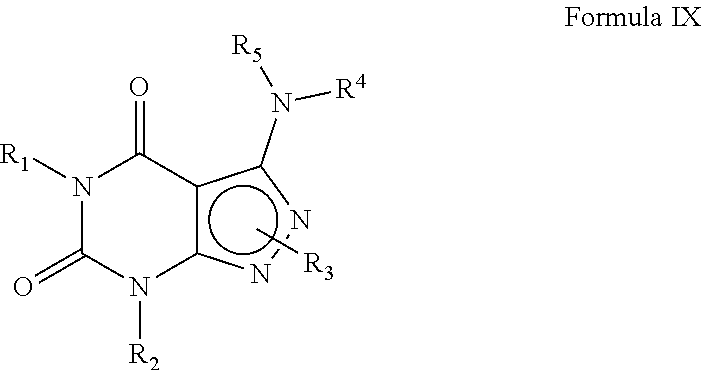

























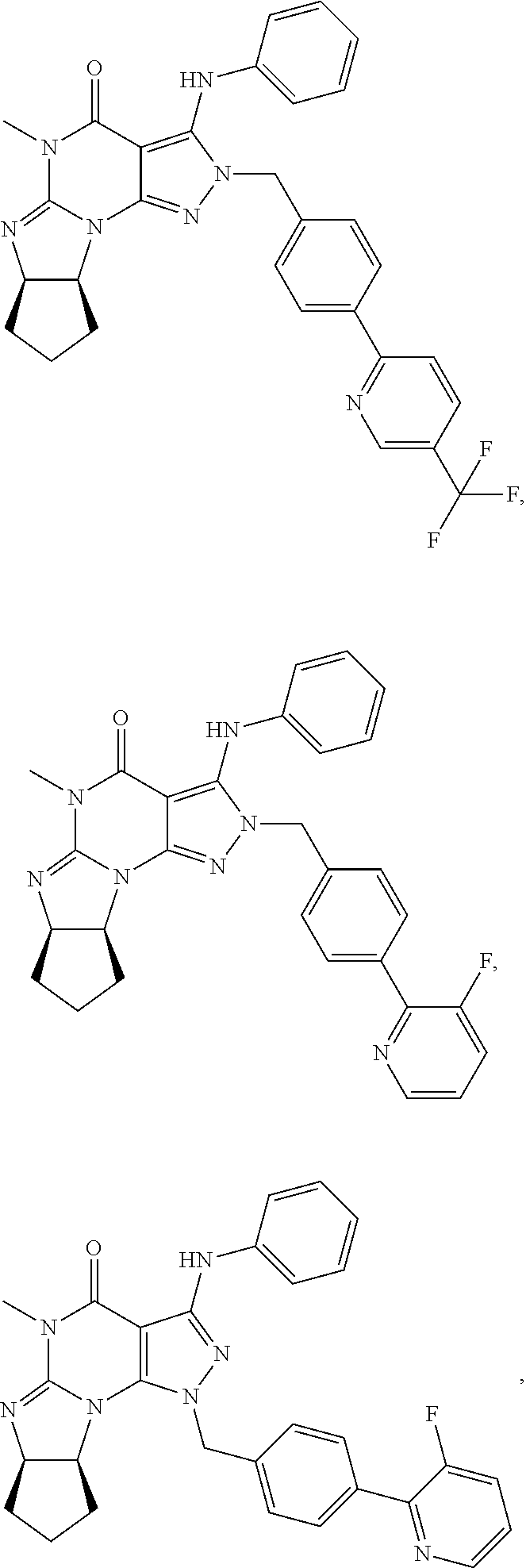








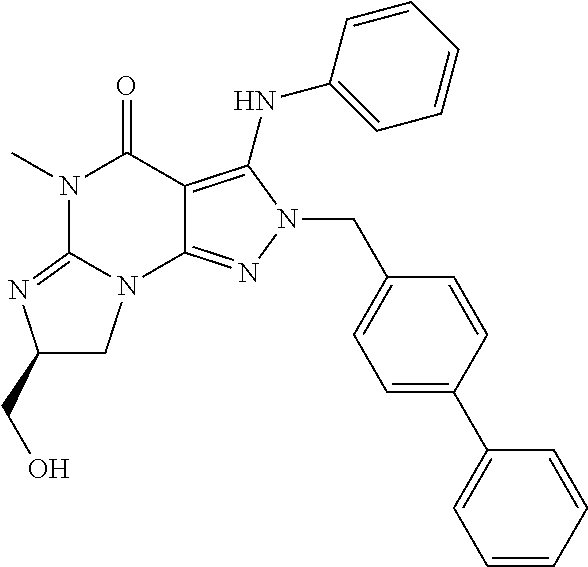



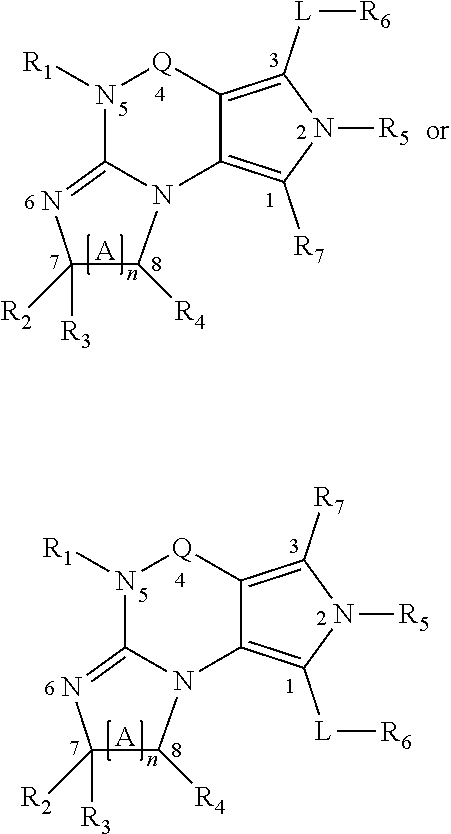

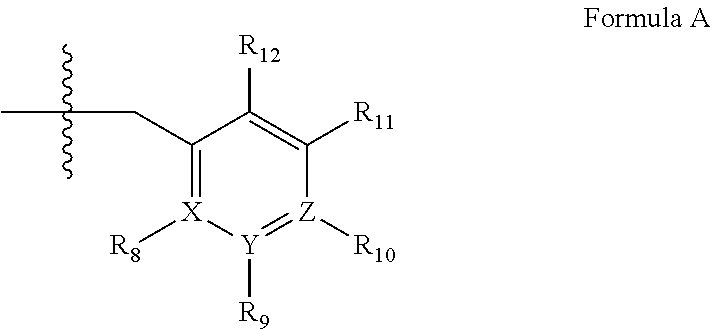



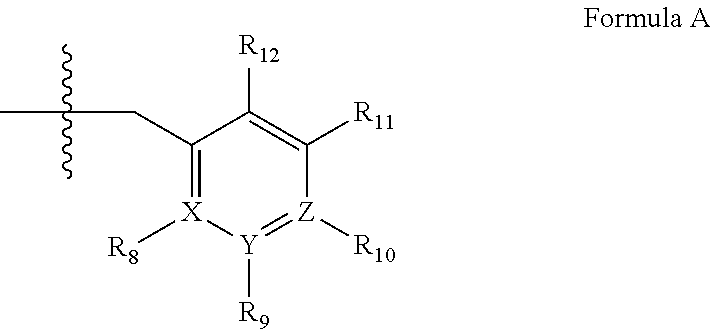

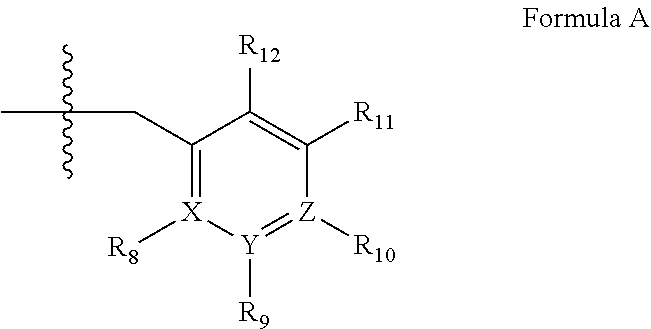

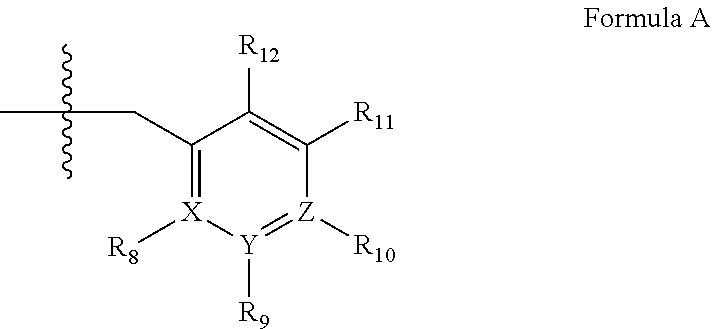
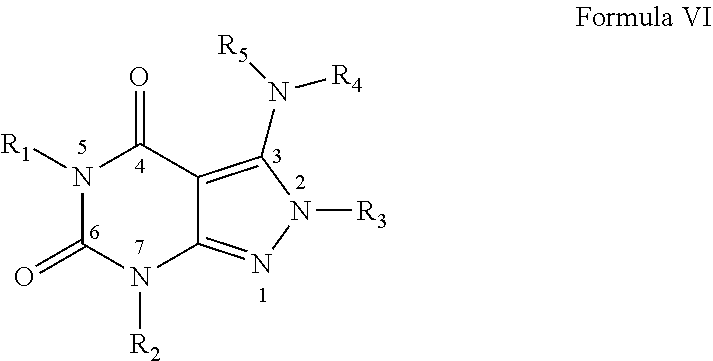

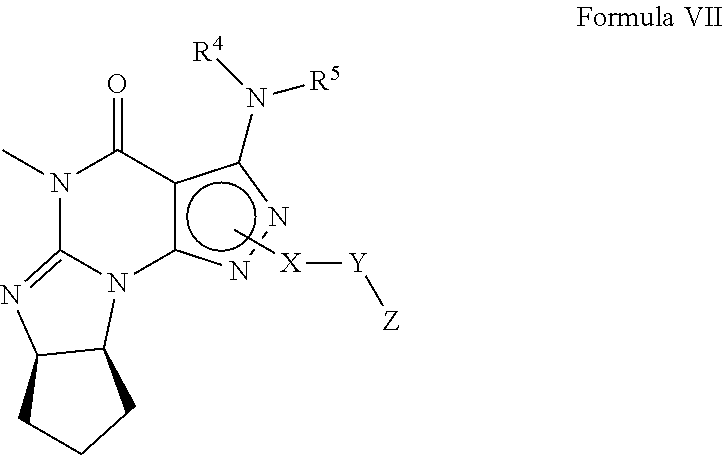

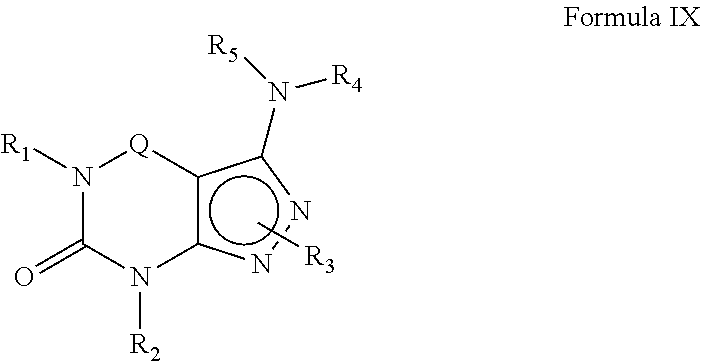
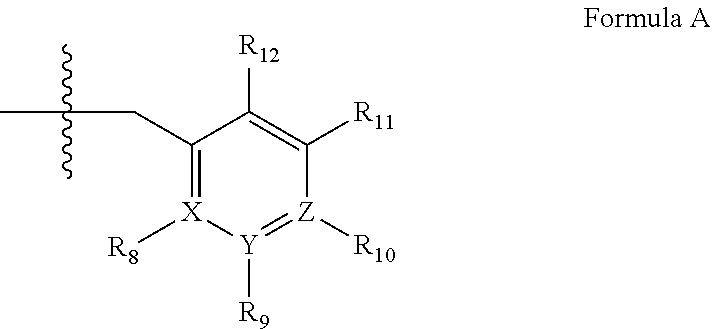
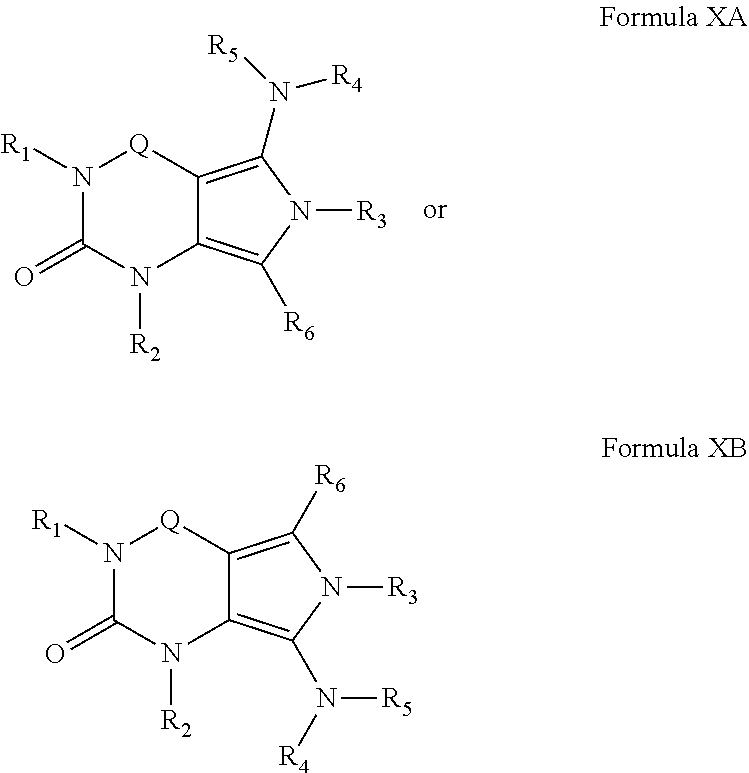
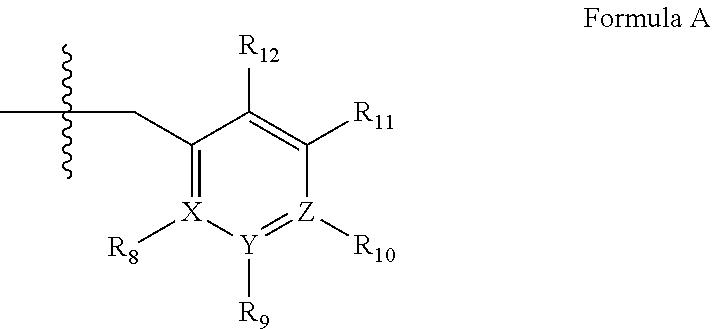

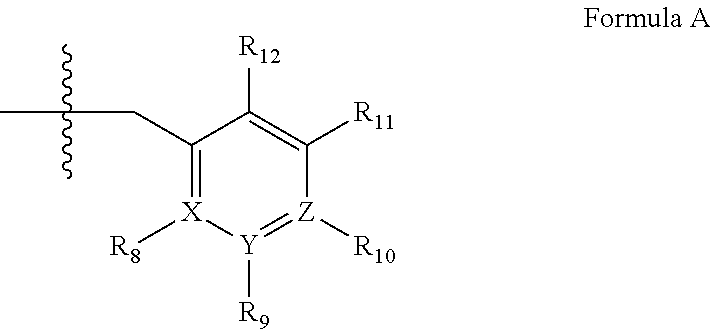
XML
uspto.report is an independent third-party trademark research tool that is not affiliated, endorsed, or sponsored by the United States Patent and Trademark Office (USPTO) or any other governmental organization. The information provided by uspto.report is based on publicly available data at the time of writing and is intended for informational purposes only.
While we strive to provide accurate and up-to-date information, we do not guarantee the accuracy, completeness, reliability, or suitability of the information displayed on this site. The use of this site is at your own risk. Any reliance you place on such information is therefore strictly at your own risk.
All official trademark data, including owner information, should be verified by visiting the official USPTO website at www.uspto.gov. This site is not intended to replace professional legal advice and should not be used as a substitute for consulting with a legal professional who is knowledgeable about trademark law.